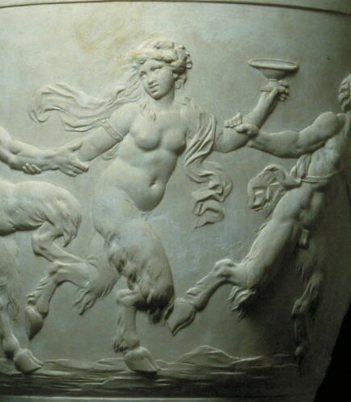Le baron Pierre-Victor de Besenval
+6
Comtesse Diane
Gouverneur Morris
attachboy
Mme de Sabran
Lucius
fleurdelys
10 participants
LE FORUM DE MARIE-ANTOINETTE :: La famille royale et les contemporains de Marie-Antoinette :: Autres contemporains : les hommes du XVIIIe siècle
Page 3 sur 4
Page 3 sur 4 •  1, 2, 3, 4
1, 2, 3, 4 
 Re: Le baron Pierre-Victor de Besenval
Re: Le baron Pierre-Victor de Besenval
Toutes ces beautés ... 
 ... nan mais ! ...ça va finir que je vais avoir un malaise !
... nan mais ! ...ça va finir que je vais avoir un malaise ! 


Bon ... c'est le coup de foudre !

 ... nan mais ! ...ça va finir que je vais avoir un malaise !
... nan mais ! ...ça va finir que je vais avoir un malaise ! 


Bon ... c'est le coup de foudre !

_________________


Comtesse Diane- Messages : 7397
Date d'inscription : 21/12/2013
Localisation : TOURAINE
 Re: Le baron Pierre-Victor de Besenval
Re: Le baron Pierre-Victor de Besenval
Oui...On imagine la salle de bain ! 
Que le site de l'ambassade de Suisse à Paris (qui occupe aujourd'hui cet hôtel particulier) nomme... un nymphée.
J'ai découvert ce mot.
Je les cite (extraits) :
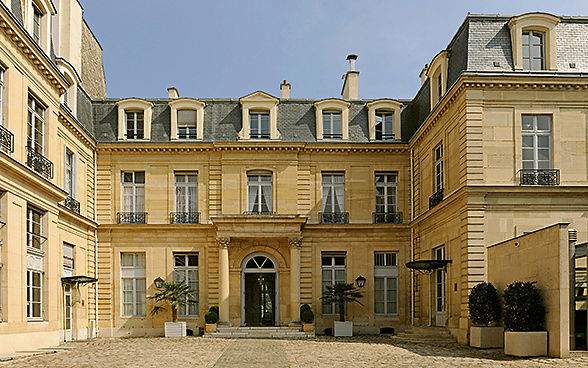
Au sous-sol, il fit aménager un nymphée dont la décoration sera l'oeuvre du sculpteur Clodion.
Les chroniqueurs de l'époque rapportèrent que l'on parla beaucoup à Paris de cette piscine qui, dit-on, ne servit qu'une seule fois ; l'eau y étant chaude et la cave glaciale, le seul baigneur, un soldat des Gardes suisses, qui s'y hasarda mourut quelques jours plus tard d'une pneumonie !
Les statues et bas-reliefs de Clodion ornant ce nymphée sont maintenant exposés au Musée du Louvre (aile Richelieu) et il ne reste aujourd'hui qu'une plaque rappelant l'existence de ces bains souterrains.
Besenval décéda dans son hôtel en 1791 en le léguant, ainsi que tous ses biens, au Maréchal de Ségur.
* Source : https://www.eda.admin.ch/countries/france/fr/home/representations/ambassade-a-paris/batiment.html

Que le site de l'ambassade de Suisse à Paris (qui occupe aujourd'hui cet hôtel particulier) nomme... un nymphée.
J'ai découvert ce mot.
Je les cite (extraits) :

Au sous-sol, il fit aménager un nymphée dont la décoration sera l'oeuvre du sculpteur Clodion.
Les chroniqueurs de l'époque rapportèrent que l'on parla beaucoup à Paris de cette piscine qui, dit-on, ne servit qu'une seule fois ; l'eau y étant chaude et la cave glaciale, le seul baigneur, un soldat des Gardes suisses, qui s'y hasarda mourut quelques jours plus tard d'une pneumonie !
Les statues et bas-reliefs de Clodion ornant ce nymphée sont maintenant exposés au Musée du Louvre (aile Richelieu) et il ne reste aujourd'hui qu'une plaque rappelant l'existence de ces bains souterrains.
Besenval décéda dans son hôtel en 1791 en le léguant, ainsi que tous ses biens, au Maréchal de Ségur.
* Source : https://www.eda.admin.ch/countries/france/fr/home/representations/ambassade-a-paris/batiment.html
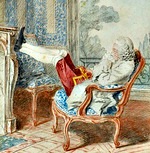
La nuit, la neige- Messages : 18132
Date d'inscription : 21/12/2013
 Re: Le baron Pierre-Victor de Besenval
Re: Le baron Pierre-Victor de Besenval
J'adore, j'adore, j'adore !!!

Tes photos sont merveilleuses, Ta Grâce !!!

Nous reconnaissons Pan, toujours lubrique, se jetant sur la nymphe Syrinx . Pour lui échapper, elle se transforme en roseaux dont il cueille une brassée avec laquelle il confectionne sa si célèbre flûte .
_________________
... demain est un autre jour .

Mme de Sabran- Messages : 55497
Date d'inscription : 21/12/2013
Localisation : l'Ouest sauvage
 Re: Le baron Pierre-Victor de Besenval
Re: Le baron Pierre-Victor de Besenval
La nuit, la neige a écrit:
Les chroniqueurs de l'époque rapportèrent que l'on parla beaucoup à Paris de cette piscine qui, dit-on, ne servit qu'une seule fois ; l'eau y étant chaude et la cave glaciale, le seul baigneur, un soldat des Gardes suisses, qui s'y hasarda mourut quelques jours plus tard d'une pneumonie !
Comme quoi l'hygiène est une excentricité dangereuse : ne nous lavons plus, les amis !

_________________
... demain est un autre jour .

Mme de Sabran- Messages : 55497
Date d'inscription : 21/12/2013
Localisation : l'Ouest sauvage

Comtesse Diane- Messages : 7397
Date d'inscription : 21/12/2013
Localisation : TOURAINE
 Re: Le baron Pierre-Victor de Besenval
Re: Le baron Pierre-Victor de Besenval
 ) ont été conservés.
) ont été conservés.Pas si mal, pas si mal.
Mais il manque les cheminées, en effet...

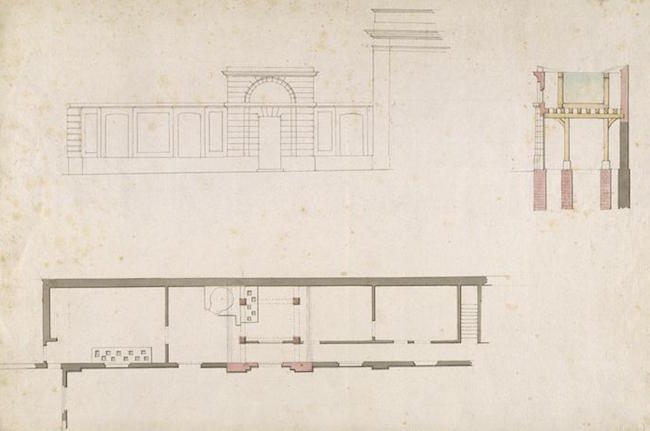
Alexandre-Théodore Brongniart
Paris, Hôtel de Besenval : nymphée souterrain à l'antique
Photo (C) RMN-Grand Palais / Michèle Bellot
Musée du Louvre

Alexandre-Théodore Brongniart
Paris, Hôtel de Besenval : nymphée souterrain à l'antique
Photo (C) RMN-Grand Palais / Michèle Bellot
Musée du Louvre
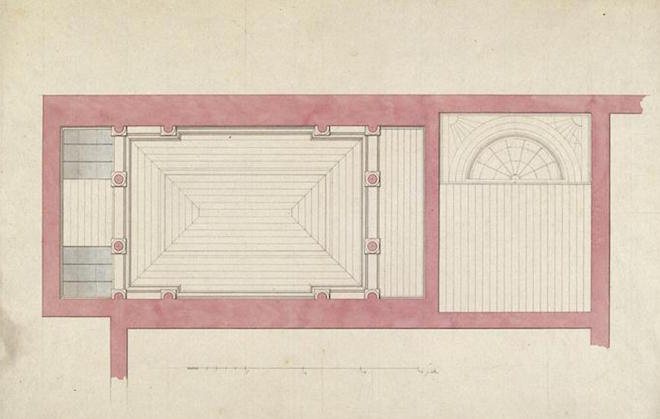
Alexandre-Théodore Brongniart
Paris, Hôtel de Besenval : nymphée souterrain à l'antique
Photo (C) RMN-Grand Palais / Michèle Bellot
Musée du Louvre

Alexandre-Théodore Brongniart
Paris, Hôtel de Besenval : nymphée souterrain à l'antique
Photo (C) RMN-Grand Palais / Michèle Bellot
Musée du Louvre
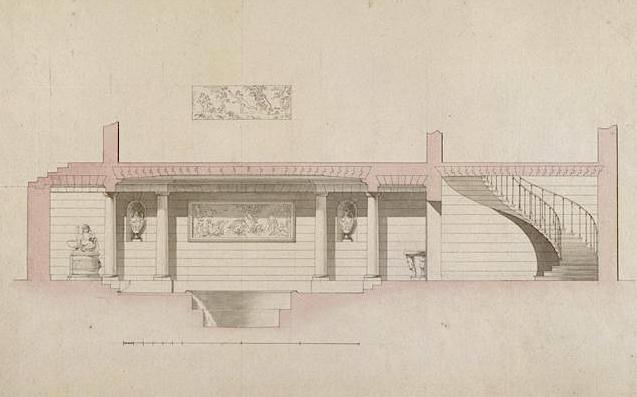
Alexandre-Théodore Brongniart
Paris, Hôtel de Besenval : nymphée souterrain à l'antique
Photo (C) RMN-Grand Palais / Michèle Bellot
Musée du Louvre
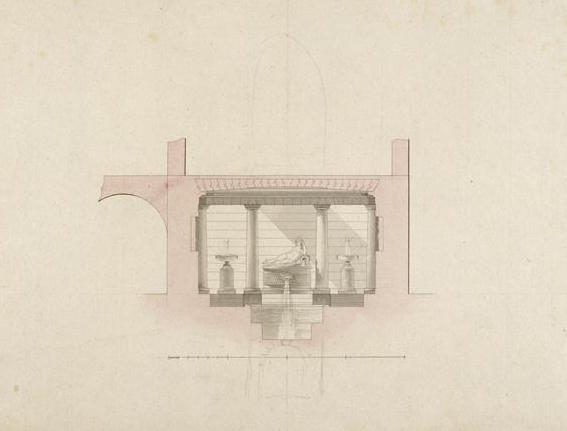
Alexandre-Théodore Brongniart
Paris, Hôtel de Besenval : nymphée souterrain à l'antique
Photo (C) RMN-Grand Palais / Michèle Bellot
Musée du Louvre

Alexandre-Théodore Brongniart
Paris, Hôtel de Besenval : nymphée souterrain à l'antique
Photo (C) RMN-Grand Palais / Michèle Bellot
Musée du Louvre

La nuit, la neige- Messages : 18132
Date d'inscription : 21/12/2013
 Re: Le baron Pierre-Victor de Besenval
Re: Le baron Pierre-Victor de Besenval
Merci, cher la nuit, la neige ......
La nuit, la neige a écrit: désormais, je ne dirai plus salle de bain
... moi non plus !
 Ah tais-toi, nous serons du dernier chic !
Ah tais-toi, nous serons du dernier chic !_________________
... demain est un autre jour .

Mme de Sabran- Messages : 55497
Date d'inscription : 21/12/2013
Localisation : l'Ouest sauvage
 Re: Le baron Pierre-Victor de Besenval
Re: Le baron Pierre-Victor de Besenval
Ces nymphées sont si inimaginables qu'elles m'ont fait l'effet d'une douche froide ! 

_________________


Comtesse Diane- Messages : 7397
Date d'inscription : 21/12/2013
Localisation : TOURAINE
 Re: Le baron Pierre-Victor de Besenval
Re: Le baron Pierre-Victor de Besenval
Notre Bombelles toujours écrit que, lorsque l'on a affaire au ministre de la guerre, Ségur, quelqu'un vous dit : " Parlez au Suisse ", qui répond " Il n'y a personne au logis ". Or ce Suisse est le baron de Besenval, ami intime du ministre, qui fait les honneurs de sa tête après s'être occupé de si longues années de la couronner de cet ornement si commun et si redouté des maris ...

_________________
... demain est un autre jour .

Mme de Sabran- Messages : 55497
Date d'inscription : 21/12/2013
Localisation : l'Ouest sauvage
 Re: Le baron Pierre-Victor de Besenval
Re: Le baron Pierre-Victor de Besenval
Besenval a-t-il donc été l'amant de la femme de Ségur ?

Duc d'Ostrogothie- Messages : 3227
Date d'inscription : 04/11/2017
 Re: Le baron Pierre-Victor de Besenval
Re: Le baron Pierre-Victor de Besenval
Voyons ! tout le monde sait cela .
Il est ( presque de notoriété publique ) le père du comte de Ségur suivant .

_________________
... demain est un autre jour .

Mme de Sabran- Messages : 55497
Date d'inscription : 21/12/2013
Localisation : l'Ouest sauvage
 Re: Le baron Pierre-Victor de Besenval
Re: Le baron Pierre-Victor de Besenval
Si le maréchal de Ségur a benoîtement endossé la paternité d'un rejeton de Besenval, lui-même avait pour mère une enfant naturelle ... du Régent Philippe d'Orléans !
La liaison du duc d'Orléans avec Mlle Desmares n'avait pas été un long fleuve tranquille . Ruptures et raccommodements successifs l'avaient jalonnée, en faisant une des hardiesses d'un temps où l'on ne s'effarouchait pas aisément .
Mlle Desmares, de la Comédie française, était fraîche, blanche, bien faite, vive et enivrante . On ne l'aimait pas, on l'adorait .

Le duc de Noailles explique fort bien comment le scandale des enfants légitimés trouvait grâce devant l'opinion, en vertu même du principe de l'autorité monarchique qui conférait au roi, avec le droit de légitimation, le pouvoir de s'absoudre lui-même de ses fautes .
Du reste, la Palatine prit la petite fille en affection :
Madame disait à tout le monde qu'elle ne trouvait sa ressemblance que dans les bâtards de son fils . Elle servit de mère à tous, les aima comme les autres et en eut plus de soins .
( Mémoires de Richelieu )
Cette enfant, mariée le 13 septembre 1718 à Henri-François de Ségur, était Philippe-Angélique de Froissy .
La voici, âgée, avec son petit fils ( le petit Besenval junior, peut-être ??? )

_________________
... demain est un autre jour .

Mme de Sabran- Messages : 55497
Date d'inscription : 21/12/2013
Localisation : l'Ouest sauvage
 Re: Le baron Pierre-Victor de Besenval
Re: Le baron Pierre-Victor de Besenval
... et Benedetta Cravieri :
A la différence de son frère, Joseph-Alexandre, il ( le comte Louis-Philippe de Ségur ) ne voyait pas dans la réussite mondaine une fin en soi, mais une étape obligée sur la rute du succès. Il n'avait ni la beauté physique ni l'élégance naturelle du vicomte - lequel d'ailleurs les avait héritées du baron de Besenval - , et le libertinage n'était pas son fort .
( Les derniers libertins )
_________________
... demain est un autre jour .

Mme de Sabran- Messages : 55497
Date d'inscription : 21/12/2013
Localisation : l'Ouest sauvage
 Re: Le baron Pierre-Victor de Besenval
Re: Le baron Pierre-Victor de Besenval
Il fallait oser...Besenval l'a fait ! 
Acheté par le baron lors d'une vente aux enchères, ce meuble appartenait initialement Marie-Joséphine Laguerre, une actrice - chanteuse d'opera.
Cette spectaculaire commode est aujourd'hui conservée au sein de la Royal Collection Trust, dont je copie ici quelques extraits de la fiche descriptive :
Commode (commode à vantaux)
Martin Carlin, 1778 - Stamped four times MARTIN JME
Oak, ebony, pietra dura, gilt bronze, marble
Green Drawing Room, Buckingham Palace
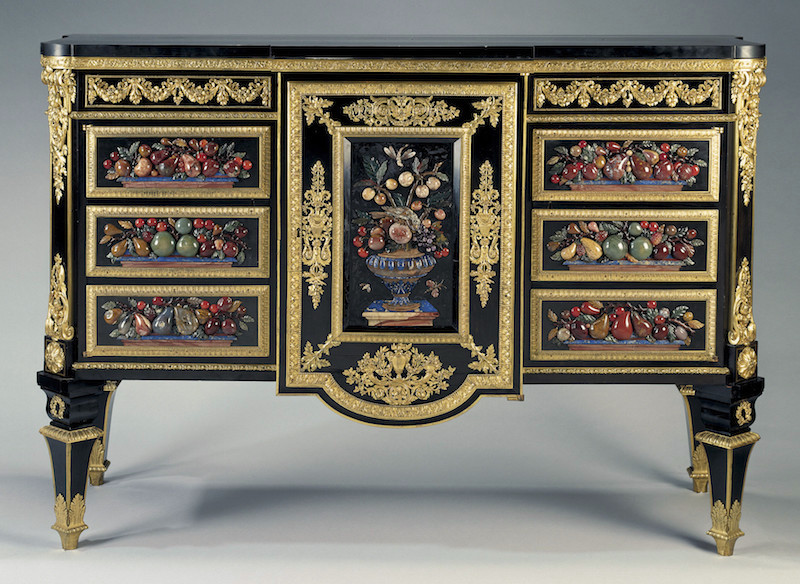
Photo : The Royal Collection Trust
Description (extraits) :
(...)
The panels themselves almost certainly come from one of the great cabinets made for Louis XIV in the royal workshops at the Gobelins; during conservation, two of the relief panels were found to be signed on the back Gachetti [sic], for Gian Ambrogio Giachetti, a Florentine lapidary working at the Gobelins between 1670 and 1675.
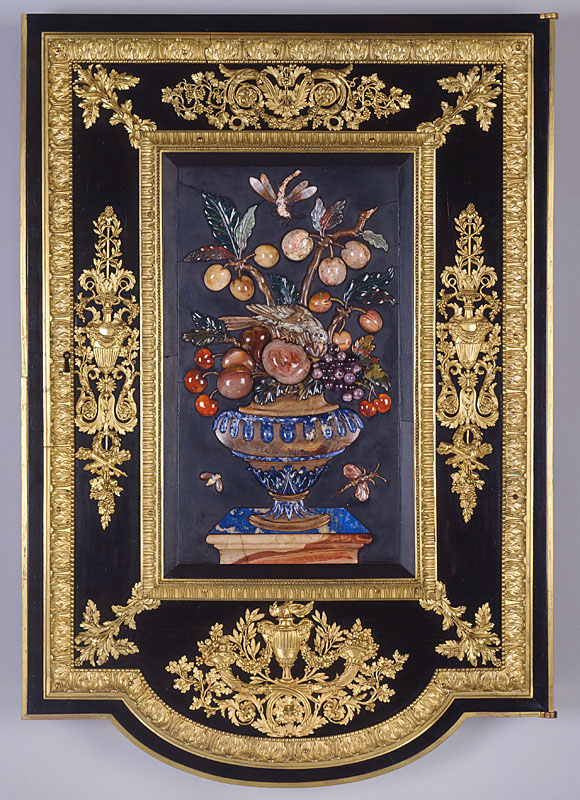
Photo : The Royal Collection Trust
Most of these royal cabinets were broken up in the eighteenth century as they went out of fashion, but the pietra dura panels were preserved as precious objects in their own right. With the revival of interest in the Louis XIV period during the 1760s and 1770s, these panels began to be recycled on neo-classical furniture.
Among the marchands-merciers (dealer-decorators) who specialised in this field were P.-F. Julliot and Dominique Daguerre.
(...)
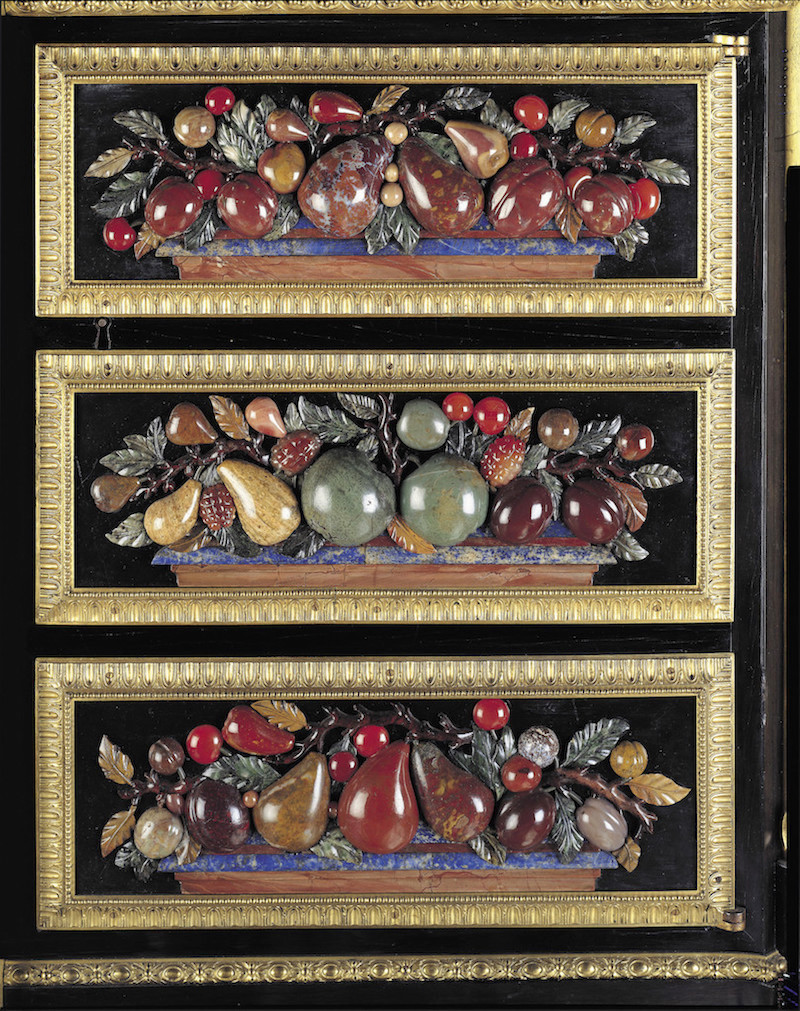
Photo : The Royal Collection Trust
The first owner of this cabinet was the notorious Parisian opera singer Marie-Joséphine Laguerre (1754-82), whose dissolute life led her to an early grave.

It appeared in the sale of her collection, among other furniture by Carlin and Weisweiler.
Subsequently it belonged to Baron de Besenval, Colonel of the Swiss Guards and friend of Marie-Antoinette, at whose sale in 1795 Daguerre's connection with its manufacture was first noted.
George IV, whose liking for pietra dura was almost as marked and long lived as his love of Sèvres porcelain, acquired the cabinet in Paris in 1828 (...)
* Source et infos complémentaires : https://www.royalcollection.org.uk/

Acheté par le baron lors d'une vente aux enchères, ce meuble appartenait initialement Marie-Joséphine Laguerre, une actrice - chanteuse d'opera.
Cette spectaculaire commode est aujourd'hui conservée au sein de la Royal Collection Trust, dont je copie ici quelques extraits de la fiche descriptive :
Commode (commode à vantaux)
Martin Carlin, 1778 - Stamped four times MARTIN JME
Oak, ebony, pietra dura, gilt bronze, marble
Green Drawing Room, Buckingham Palace

Photo : The Royal Collection Trust
Description (extraits) :
(...)
The panels themselves almost certainly come from one of the great cabinets made for Louis XIV in the royal workshops at the Gobelins; during conservation, two of the relief panels were found to be signed on the back Gachetti [sic], for Gian Ambrogio Giachetti, a Florentine lapidary working at the Gobelins between 1670 and 1675.

Photo : The Royal Collection Trust
Most of these royal cabinets were broken up in the eighteenth century as they went out of fashion, but the pietra dura panels were preserved as precious objects in their own right. With the revival of interest in the Louis XIV period during the 1760s and 1770s, these panels began to be recycled on neo-classical furniture.
Among the marchands-merciers (dealer-decorators) who specialised in this field were P.-F. Julliot and Dominique Daguerre.
(...)

Photo : The Royal Collection Trust
The first owner of this cabinet was the notorious Parisian opera singer Marie-Joséphine Laguerre (1754-82), whose dissolute life led her to an early grave.

It appeared in the sale of her collection, among other furniture by Carlin and Weisweiler.
Subsequently it belonged to Baron de Besenval, Colonel of the Swiss Guards and friend of Marie-Antoinette, at whose sale in 1795 Daguerre's connection with its manufacture was first noted.
George IV, whose liking for pietra dura was almost as marked and long lived as his love of Sèvres porcelain, acquired the cabinet in Paris in 1828 (...)
* Source et infos complémentaires : https://www.royalcollection.org.uk/

La nuit, la neige- Messages : 18132
Date d'inscription : 21/12/2013
 Re: Le baron Pierre-Victor de Besenval
Re: Le baron Pierre-Victor de Besenval
La nuit, la neige a écrit:
The first owner of this cabinet was the notorious Parisian opera singer Marie-Joséphine Laguerre (1754-82), whose dissolute life led her to an early grave.

... ben oui quoi, une épicurienne !
Le relief des fruits en pierres dures, oiseau, papillons, libellule : ce meuble est prodigieux !!!

_________________
... demain est un autre jour .

Mme de Sabran- Messages : 55497
Date d'inscription : 21/12/2013
Localisation : l'Ouest sauvage
 Re: Le baron Pierre-Victor de Besenval
Re: Le baron Pierre-Victor de Besenval
C'est le "Louis XIV revival" de la fin du XVIIIème siècle . 
L'ajout de pierres dures sur la commode Besenval la rend tout à fait extraordinaire et unique.
La commode de Levasseur réalisée pour la chambre à coucher du comte d'Artois au palais du Temple (aujourd'hui exposée dans la chambre de parade de la duchesse de Chevreuse au Louvre), avec sa marqueterie Boulle réemployée, procède du même courant "Louis XIV revival".
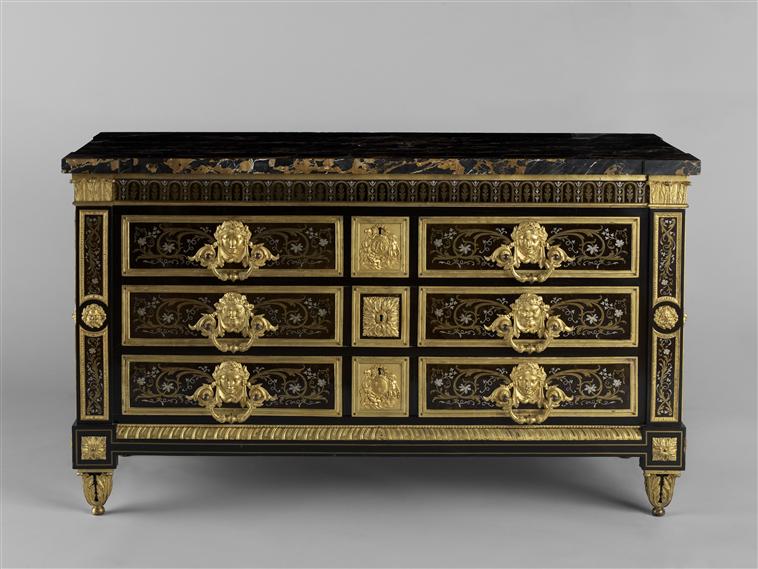

L'ajout de pierres dures sur la commode Besenval la rend tout à fait extraordinaire et unique.
La commode de Levasseur réalisée pour la chambre à coucher du comte d'Artois au palais du Temple (aujourd'hui exposée dans la chambre de parade de la duchesse de Chevreuse au Louvre), avec sa marqueterie Boulle réemployée, procède du même courant "Louis XIV revival".


Duc d'Ostrogothie- Messages : 3227
Date d'inscription : 04/11/2017

Gouverneur Morris- Messages : 11795
Date d'inscription : 21/12/2013
 Re: Le baron Pierre-Victor de Besenval
Re: Le baron Pierre-Victor de Besenval
Ah ?
C'est vrai que l'on se passerait volontiers de quelques garnitures.
Je vais ouvrir un petit sujet avec quelques meubles décorés de pietra dura de sa collection.
C'est quelque chose !
C'est vrai que l'on se passerait volontiers de quelques garnitures.
Je vais ouvrir un petit sujet avec quelques meubles décorés de pietra dura de sa collection.
C'est quelque chose !

La nuit, la neige- Messages : 18132
Date d'inscription : 21/12/2013
 Re: Le baron Pierre-Victor de Besenval
Re: Le baron Pierre-Victor de Besenval
En amont de ce sujet, nous avions déjà posté des images de quelques objets que nous retrouvons sur le portrait iconique du baron de Besenval, par Henri-Pierre Danloux :

Photos : Sotheby's

Photo : Sotheby's

Photo : Mme de Sabran / Musée Calouste Gulbenkian de Lisbonne
 The Royal Collection Trust conserve également cette jolie paire d'aiguières, dont je cite quelques extraits du descriptif ainsi qu'une image intéressante, qui présente une pièce et ses montures désassemblées :
The Royal Collection Trust conserve également cette jolie paire d'aiguières, dont je cite quelques extraits du descriptif ainsi qu'une image intéressante, qui présente une pièce et ses montures désassemblées :
Pair of mounted ewers vases (Jingdezhen / Jiangxi Province, China) 1730-40
Mounts (France) c.1745-55
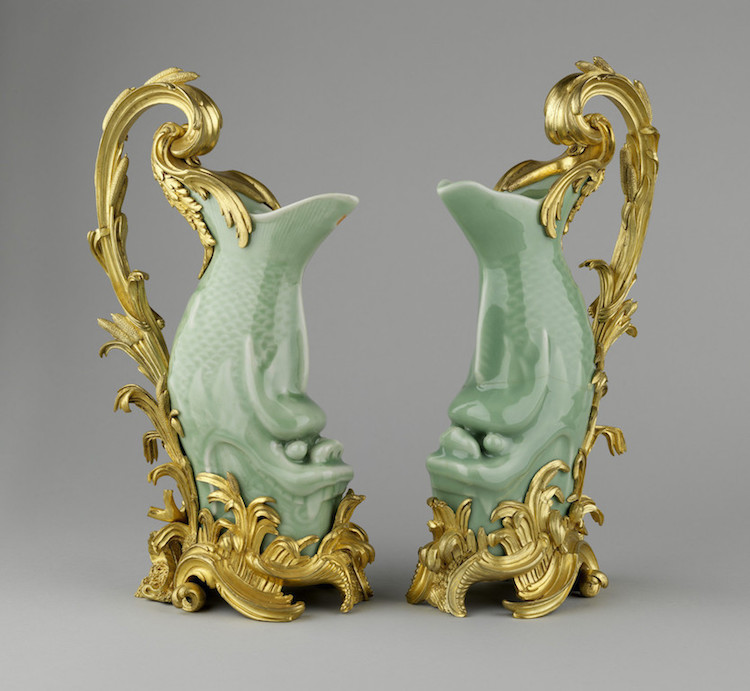
Photo : The Royal Collection Trust
These Chinese celadon vases, each in the form in the form of a hollow Ao (aoyu) fish, grotesque carp, were made in China in around 1740 and not long afterwards were mounted as ewers in France.
The two vases were not made in the same mould and their glazes are markedly different, indicating that they may have been made into a pair by the marchand-mercier responsible for mounting them. Their form suggests that they may in fact have been made for the purpose of mounting in the West.
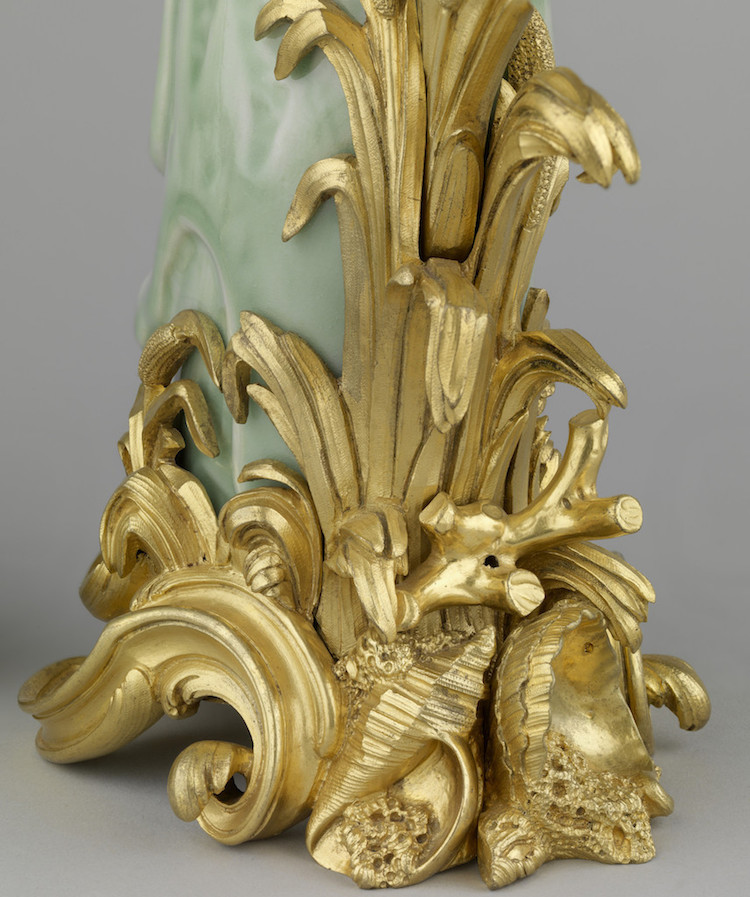
Photo : The Royal Collection Trust
The gilt bronze mounts separate into six pieces (the handle, the two sides of the base, the acanthus-leaf mount of the tail, one of the shells at the back and a base plate), which are screwed together in such a way as to disguise the joins.

Photo : The Royal Collection Trust
Vases of this type arrived in France in some numbers. A similar vase with the same design of mounts appears in a painting of the Baron de Besenval of 1790-1 by Henri-Pierre Danloux (National Gallery, London), and a closely related pair of ewers is in the National Gallery of Art, Washington DC (...).
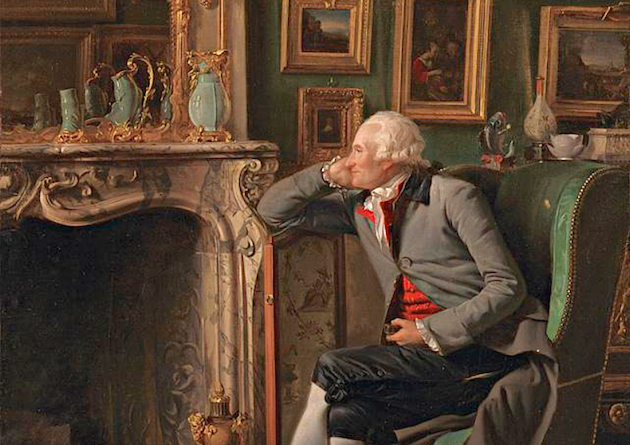
Photo : National Gallery

Photo : The Royal Collection Trust
The monochrome grey-green celadon glaze which had been a staple of the Longquan kilns for centuries during the Ming period and earlier was taken up by the porcelain factories of Jingdezhen in the seventeenth century; and from the reign of Kangxi (1662–1722) onwards, wares of distinction were made in this style, frequently with reticent incised decoration.
They were among those which the marchand-merciers of Paris most often sought out for mounting in gilt bronze, and many fine examples of their art, together with that of English bronze makers, displayed to effect at the Royal Pavilion, Brighton, were brought together by George IV.
(...)
 Source : Text adapted from Chinese and Japanese Works of Art in the Collection of Her Majesty The Queen: Volume II and from Royal Treasures, A Golden Jubilee Celebration, London 2002
Source : Text adapted from Chinese and Japanese Works of Art in the Collection of Her Majesty The Queen: Volume II and from Royal Treasures, A Golden Jubilee Celebration, London 2002
https://www.royalcollection.org.uk/

Photos : Sotheby's

Photo : Sotheby's

Photo : Mme de Sabran / Musée Calouste Gulbenkian de Lisbonne
Pair of mounted ewers vases (Jingdezhen / Jiangxi Province, China) 1730-40
Mounts (France) c.1745-55

Photo : The Royal Collection Trust
These Chinese celadon vases, each in the form in the form of a hollow Ao (aoyu) fish, grotesque carp, were made in China in around 1740 and not long afterwards were mounted as ewers in France.
The two vases were not made in the same mould and their glazes are markedly different, indicating that they may have been made into a pair by the marchand-mercier responsible for mounting them. Their form suggests that they may in fact have been made for the purpose of mounting in the West.

Photo : The Royal Collection Trust
The gilt bronze mounts separate into six pieces (the handle, the two sides of the base, the acanthus-leaf mount of the tail, one of the shells at the back and a base plate), which are screwed together in such a way as to disguise the joins.

Photo : The Royal Collection Trust
Vases of this type arrived in France in some numbers. A similar vase with the same design of mounts appears in a painting of the Baron de Besenval of 1790-1 by Henri-Pierre Danloux (National Gallery, London), and a closely related pair of ewers is in the National Gallery of Art, Washington DC (...).

Photo : National Gallery

Photo : The Royal Collection Trust
The monochrome grey-green celadon glaze which had been a staple of the Longquan kilns for centuries during the Ming period and earlier was taken up by the porcelain factories of Jingdezhen in the seventeenth century; and from the reign of Kangxi (1662–1722) onwards, wares of distinction were made in this style, frequently with reticent incised decoration.
They were among those which the marchand-merciers of Paris most often sought out for mounting in gilt bronze, and many fine examples of their art, together with that of English bronze makers, displayed to effect at the Royal Pavilion, Brighton, were brought together by George IV.
(...)
https://www.royalcollection.org.uk/

La nuit, la neige- Messages : 18132
Date d'inscription : 21/12/2013
 Re: Le baron Pierre-Victor de Besenval
Re: Le baron Pierre-Victor de Besenval
Voici un rapprochement d'oeuvres bien plus pertinent que celui de mon précédent message. 
En effet, il se pourrait bien que nous retrouvions là les céramiques montées originales qui décoraient le portrait bien connu de Besenval.

Le baron de Besenval dans son salon de compagnie
Henri-Pierre Danloux
Huile sur toile, probablement vers 1791
46,5 cm x 37,0 cm
Image : The National Gallery
Seront prochainement présentés en vente aux enchères :
 A PAIR OF LOUIS XV ORMOLU AND CHINESE CLAIR DE LUNE CELADON PORCELAIN VASES
A PAIR OF LOUIS XV ORMOLU AND CHINESE CLAIR DE LUNE CELADON PORCELAIN VASES
THE ORMOLU MOUNTS ATTRIBUTED TO JEAN-CLAUDE CHAMBELLAN DUPLESSIS, CIRCA 1760,
THE PORCELAIN CIRCA 1720-1750
Each with flask-shaped body inspired by bronze prototypes, surmounted by a shaped oval neck centered by a rockwork shell and flanked by fluted borders and scrolls, above cherub clasps suspending floral garlands, the shaped rectangular base with reeded border and foliate and cabochon-cast corner clasps, on pierced oval feet cast with foliage
12 in. (30.5 cm.) high; 6 ¼ in. (16 cm.) wide; 4 in. (10 cm.) deep
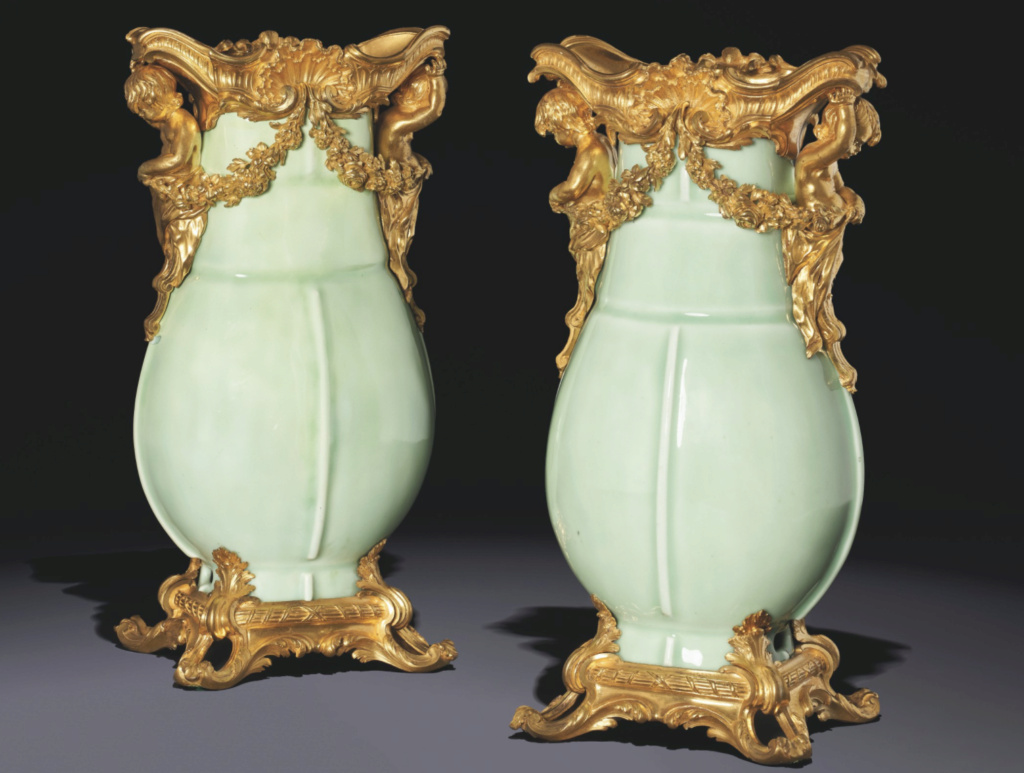
Provenance :
Almost certainly Baron de Besenval (1722-1791) in his hôtel in the rue de Grenelle, Paris, probably sold Paris, 10 August 1795 as part of lot 148.
Either acquired by Peter, 5th Earl Cowper (D. 1836), directly for Panshanger, Hertfordshire, or by Thomas, 2nd Earl de Grey (D. 1859) for Wrest Park, Hertfordshire, and subsequently through De Grey's daughter to Panshanger until circa 1953 and thereafter by descent until sold, Christie's King Street, 6 December 2007, lot 130.

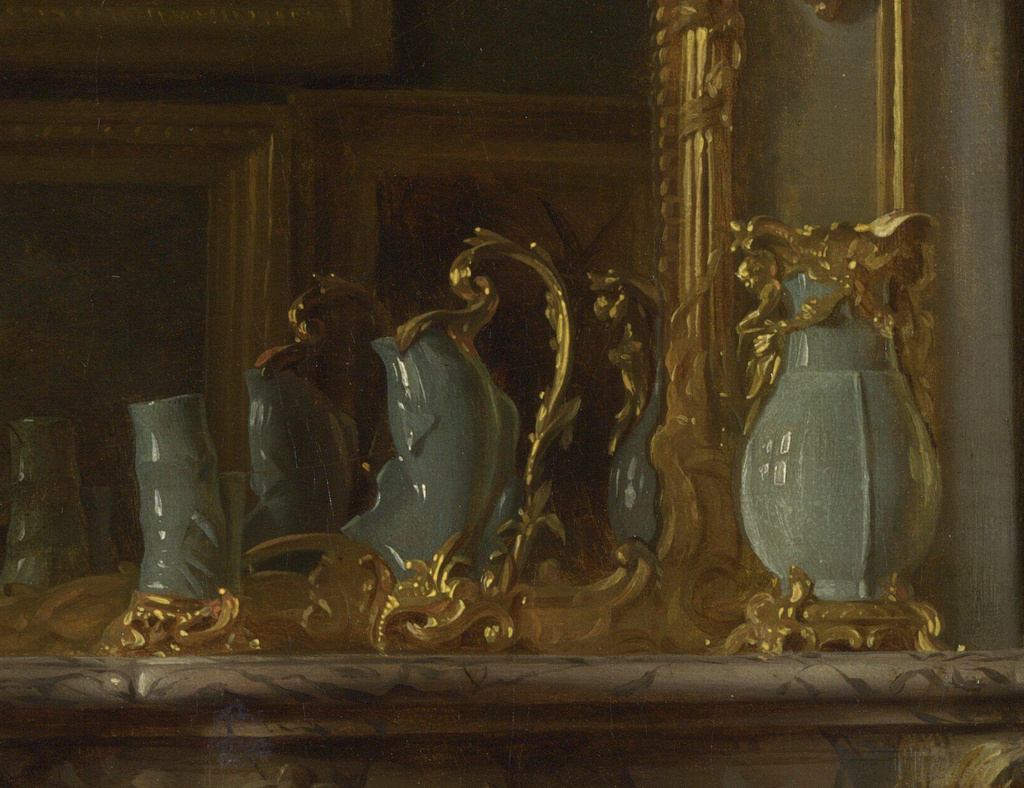
Lot Essay
Precisely depicted in Baron de Besenval’s portrait by Henri-Pierre Danloux, these sumptuously mounted vases are in the late rococo style of around 1760, which represented a reaction to the fanciful asymmetry of early rococo, the goût pittoresque of the 1730s and 1740s.
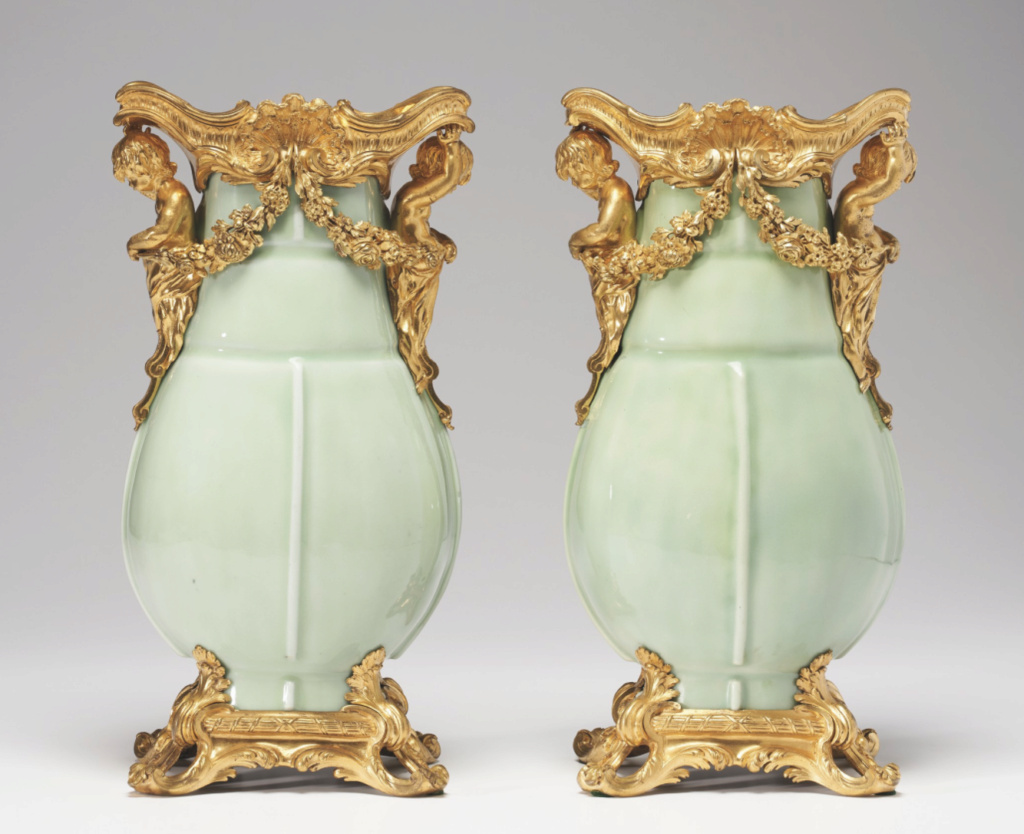
The feet and spouts are curved, and the upper rim is centred by large, shell-like rocaille, but the overall design is fully symmetrical, a feature characteristic of designer and bronzier Jean-Claude Chambellan Duplessis’ oeuvre.
The reeded lower border, the naturalistic garlands of flowers, and the figures of draped boys at the sides - supporting the rim with their right hand and holding the floral swags with their left one - herald the advent of a new classicism. At a time when an aggressive neo-classicism, the so-called goût grec, was already being advocated by a small number of avant-garde patrons and artists, many preferred the generous, sweeping forms of this rococo rectifié.
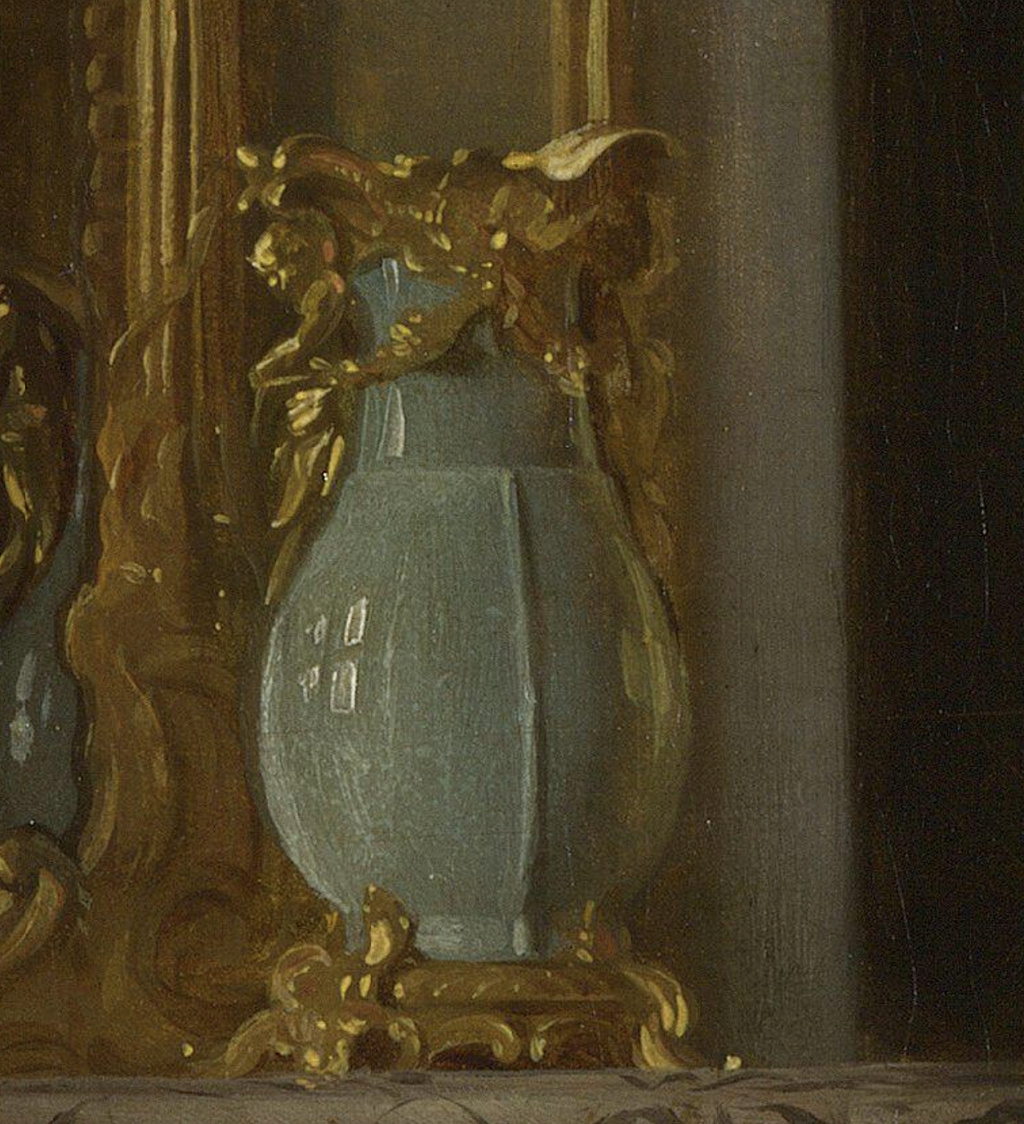

The beautifully chased mounts adorn rare celadon vases whose shape is derived from Chinese archaic bronze vessels. No other similar pair appears to be recorded, although nearly identical bases occur on other pieces, such as a pair of clair de lune pagoda vases in the Rijksmuseum (C. Jörg, Chinese ceramics in the collection of the Rijksmuseum, Amsterdam, Amsterdam-London 1977, no. 266) and a bottle-shaped vase in the Wrightsman Collection (acc. num. 49.7.80- 81, F.J.B. Watson, the Wrightsman Collection, vol. II, Furniture, gilt bronze and mounted porcelain, carpets, New York, 1966, p. 239).
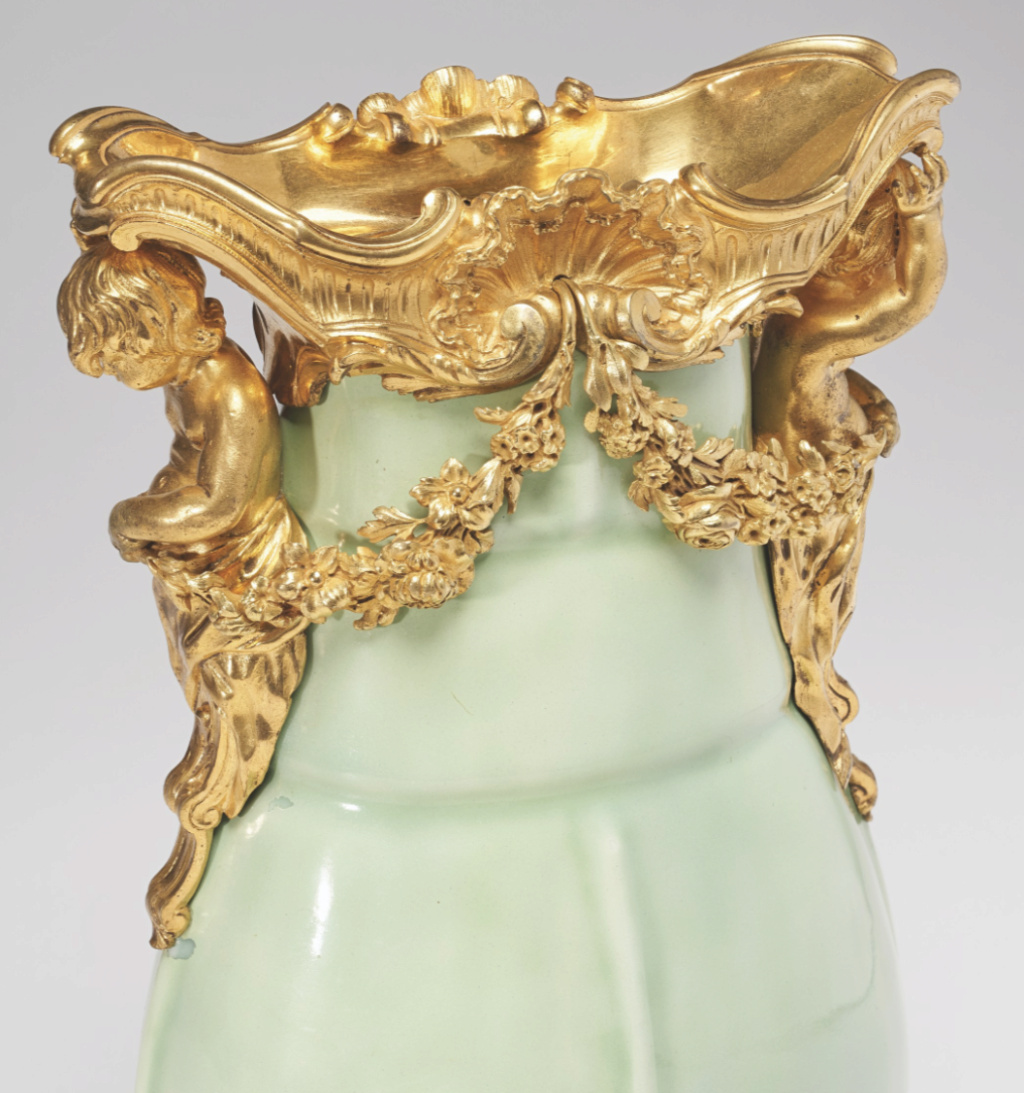
The already strong likelihood of these vases being those in the Besenval portrait is further supported by the existence of two pairs with the same mounts, but very obviously different decoration on the porcelain.
The pair mentioned above in the Wrightsman collection is decorated with relief key-pattern, the pair was in William Beckford's Collection at Fonthill, that of his son-in-law, the Duke of Hamilton at Hamilton Palace, were exhibited in William Beckford: An Eye For the Magnificent, 2006, no. 46. A further pair decorated with a second peach pattern, also in the collection of William Beckford at Fonthill, was subsequently sold Christie's London, 4 July 2013, lot 39.

TWO REGENCY COLLECTIONS : THE COWPER COLLECTION AT PANSHANGER AND THE DE GREY COLLECTION AT WREST PARK
 A PAIR OF LOUIS XV ORMOLU-MOUNTED CHINESE CELADON PORCELAIN CARP VASES
A PAIR OF LOUIS XV ORMOLU-MOUNTED CHINESE CELADON PORCELAIN CARP VASES
ALMOST CERTAINLY SUPPLIED BY LAZARE DUVAUX,
THE PORCELAIN QIANLONG (1735-1795), THE MOUNTS CIRCA 1750-1755
The porcelain bodies naturalistically modeled with a carp and its young with open mouths, each issuing elaborately chased ormolu mounts with C-scrolls and scrolled acanthus, the S-pattern handle wrapped with bulrushes and C-scrolls on elaborate naturalistically modeled plinth with bold C-scrolls, coral, acanthus, shells and sponges, the base with ormolu-applied plate to the underside
12 ½ in. (31.8 cm.) high; 7 ¼ in. (18.5 cm.) deep

Provenance :
Possibly Pierre-Victor baron de Besenval in his hôtel in the rue de Grenelle, Paris and subsequently sold Paris, 10 August 1795, as part of lot 148.
The Rodolphe Kann Collection (1844-1905), Paris.
Martin and Laura Bromberg, Hamburg; acquired from the estate of the above via Duveen & Co, London, 14 September, 1907.
Henry and Hertha Bromberg, Hamburg, by descent.
Galerie F Kleinberger (Allan Loebl), Paris, acquired from the above, circa December 1938.
Wildenstein Collection, acquired from the above, 6 March 1939.
Thence by descent in the family until sold, Christie's, King Street, 14-15 December 2005, lot 45.
Private collection, United States.
(...)
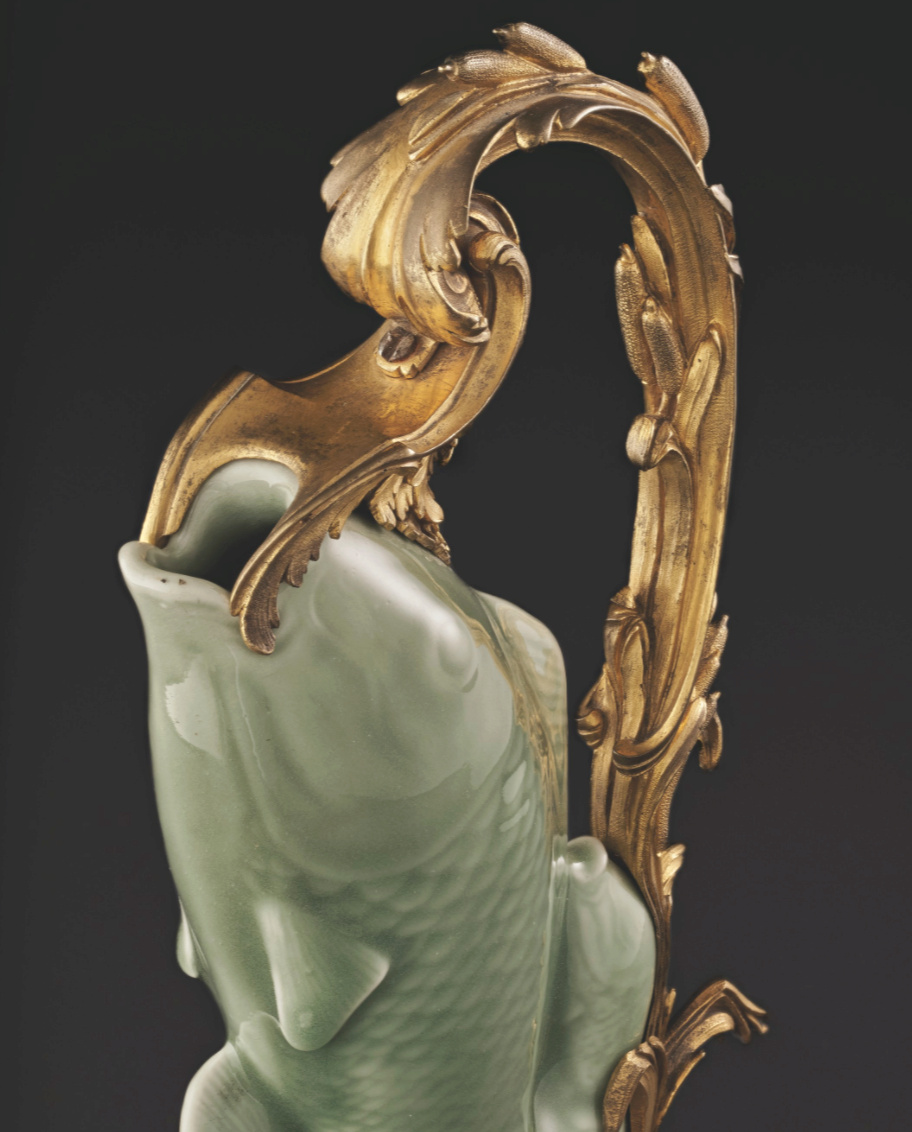
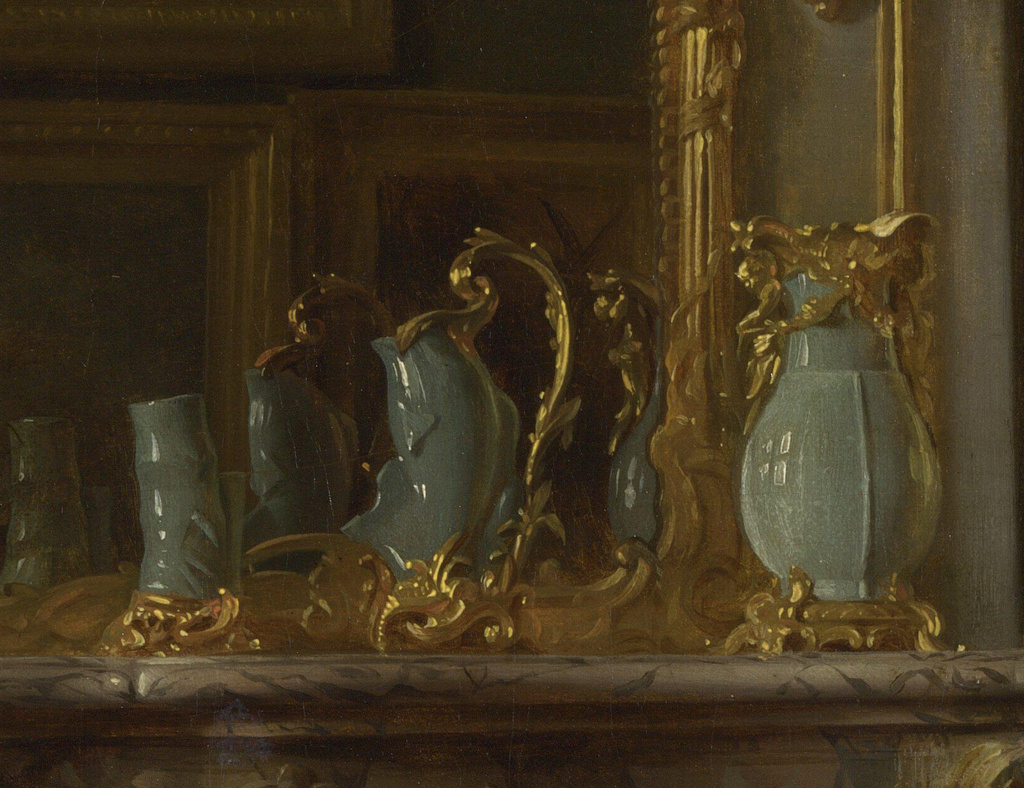
Lot Essay
This model is first recorded in the Livre-Journal of the marchand-mercier Lazare Duvaux in 1750. On 16 October, Louis XV's mistress Madame de Pompadour, (née Antoinette Poisson) acquired '621. Du 10 Mme la Marq. de Pompadour..Quatre morceaux de porcelaine céladon, dont deux en forme de cornets & deux poissons, le tout garni en bronze doré d'or moulu'.
In 1752, the marquise bought a further deux poissons céladon (cabinet de Versailles) and the taste was rapidly echoed throughout the Court, particularly amateurs like M. Gaignat, Jean de Juliennne and Blondel d'Azincourt.
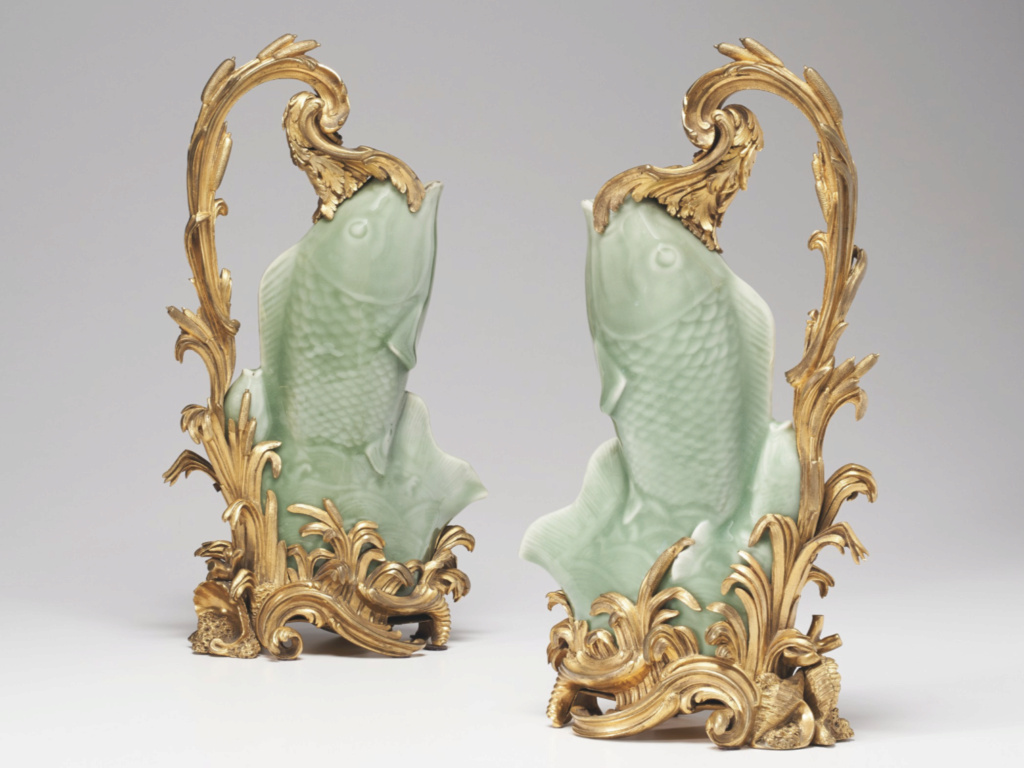
Duvaux's Livre-Journal reveals the discrepancy in cost between the varying models and the quality of the ciseleur, although the cost of the porcelain itself far exceeded that of the ormolu mounts. Thus, Watteau's great patron Jean de Julienne's pair, acquired from Duvaux on the 27 June 1753 and described as 'Deux poissons de porcelaine céladon, formant des cruches, montés en bronze doré d'or moulu cost 960 livres'; in 1751 M. Gaignat acquired 'Deux poissons d'ancienne porcelaine céladon, garnis en bronze doré d'or moulu, form de buire', which this time cost 1200 livres and was depicted by Gabriel de Saint-Aubin as marginalia in one of his sale catalogues ; the pair acquired by Blondel d'Azincourt, the Intendant des Menus-Plaisirs and a most exacting patron, were almost double the first - 17 October 1755 'M. d'Azincourt..Deux poissons aussi céladon montés en buires, 1800 l'; A pair mounted as ewers was also sold to the ‘Prince de Turenne’ on 13 December 1754 and to ‘Monseigneur le Duc d’Orléans’ on 20 March 1756.

A clearer understanding of the relative costs of such elaborate ormolu mounts vis-à-vis the porcelain can be gleaned again from Duvaux, who in 1752 supplied Madame de Pompadour with 'Quatre pieds à contours en cuivre ciselé doré d'or moulu pour deux petits vases de porcelain brune & deux poissons céladon (Cabinet de Versailles), [42 l]'.
The enduring popularity of the model throughout the second half of the 18th century is confirmed both through Duvaux's Livre-Journal and the comparatively high proliferation of this model in 18th century sale catalogues and Inventories.
Indeed, even as the ancien régime was crumbling, Louis XVI's Commander-in-Chief of the ill-fated Swiss Guards, the Baron de Besenval, was immortalised in Henri-Pierre Danloux's 1791 portrait with just such a pair of vases upon the mantelpiece.
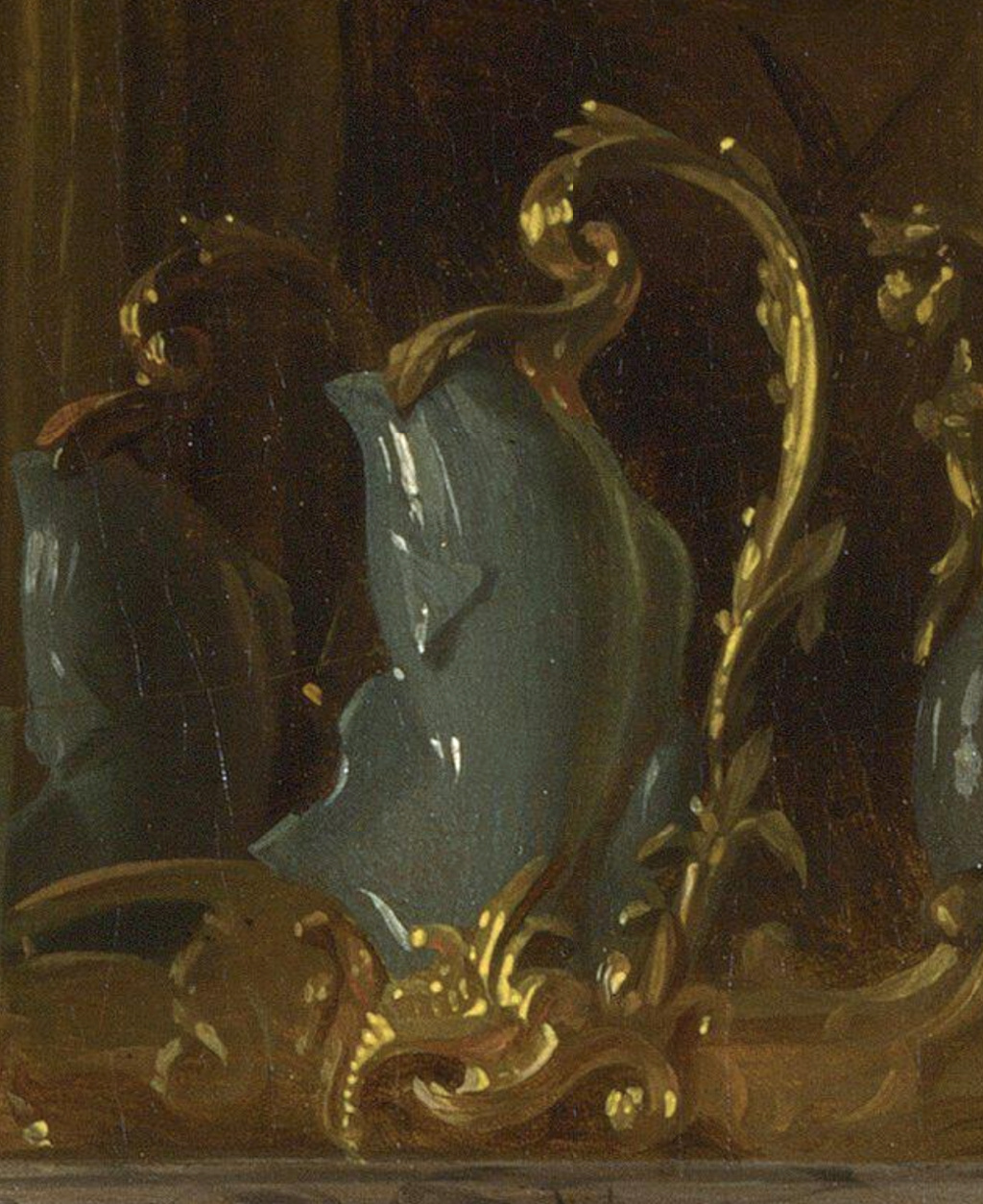
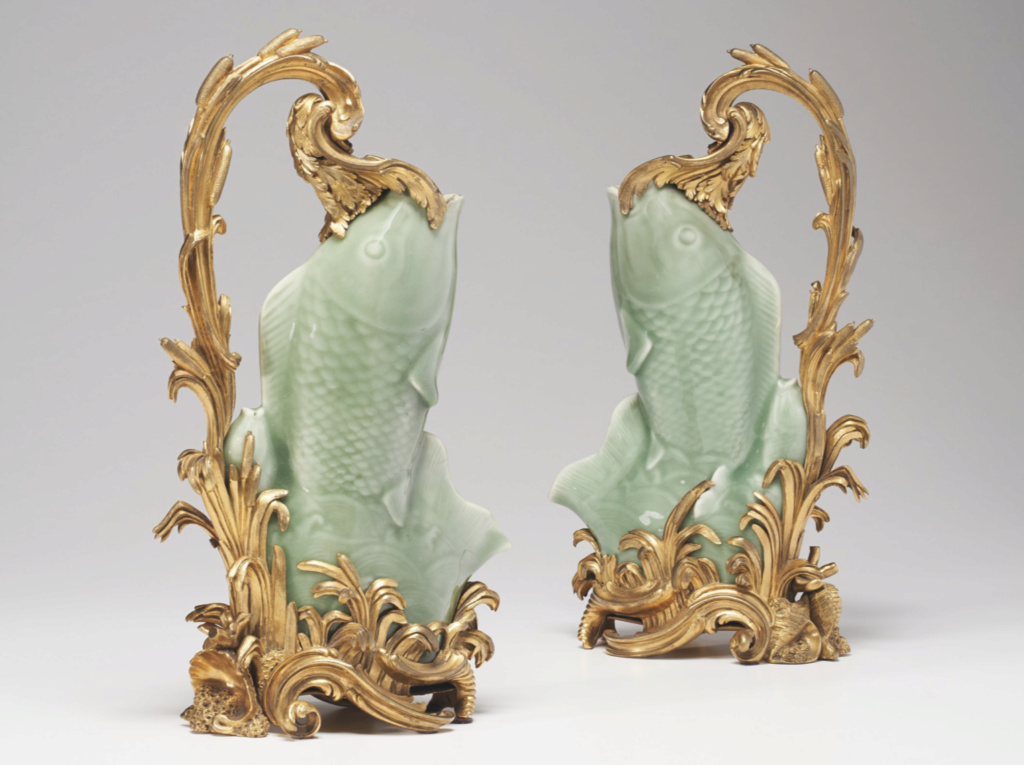
A sublime reflection of the pittoresque fantasy in the full-blown Rococo style, this form of ewer was only ever intended as ornamental. Although distinctive, categoric identification of this model in 18th century sales records is nigh on impossible owing to both the brief descriptions and the fact that three closely related models were executed, all presumably by the same bronzier working for Duvaux.
These three models comprise :
VASES OF THE WILDENSTEIN MODEL, WITH THE FISHES MOUTH AS A SPOUT:
- a pair sold from the collection of Conseulo Vanderbilt, Sotheby's, New York, 9 December 1994, lot 136. This pair is almost identical to the present and can be as well the vase visible in Danloux’s portrait of Baron de Besenval. Other pairs with slight different mounts to the carps’ lips are known:
-a pair at Harewood House, Yorkshire; these also have the same ormolu plate to the underside.
-a pair in the Royal Collection (RCIN 360).
-a garniture of three in the Calouste Gulbenkian Foundation, Lisbon (Isabel Pereira Coutinho, Gulbenkian Museum, 1998, no.100, p.126);
-a pair in The Fine Arts Museums of San Francisco (1927.165; 1927.166).
-a pair sold by Lord Robert Crichton- Stuart, Sotheby’s, London, 3 July 1959, lot 114.
-another pair was sold (without dating) from the Basil and Elise Gouland collection at Christie’s, London, 11 June 1992, lot 64.
VASES WITH THE TAIL AS THE SPOUT: these include the pair from the Hastings Collection at Melton Constable, Norfolk, now in the Widener collection at the National Gallery of Art, Washington (discussed in Sir Francis Watson, 'Mounted Oriental Porcelain', Exhibition Catalogue, Washington, 1986, no.32).
VASES IN THE FORM OF PAIRED CARP, such as the central vase of the Gulbenkian Garniture cited above, as well as that in the Victoria and Albert Museum, London (illustrated in J. Lunsingh Scheerler, Chinesisches und Japanisches Porzellan in europaîschen Fassungen, Wurzburg, 1980, p.336, fig. 329); as well as those offered anonymously at Sotheby's New York, 3 May 1986, lot 40.
THE BROMBERG FAMILY
 A PAIR OF LOUIS XV ORMOLU-MOUNTED CHINESE CELADON PORCELAIN BAMBOO-FORM BRUSHPOTS
A PAIR OF LOUIS XV ORMOLU-MOUNTED CHINESE CELADON PORCELAIN BAMBOO-FORM BRUSHPOTS
THE PORCELAIN QIANLONG (1735-1795), THE MOUNTS CIRCA 1750
Each with pierced scrolling rocaille base
7 in. (18 cm.) high

Provenance :
Possibly Pierre-Victor baron de Besenval in his hôtel in the rue de Grenelle, Paris and subsequently sold Paris, 10 August 1795, as part of lot 148.
With Michel Meyer, Paris, circa 1970.
Anonymous sale; Sotheby's Paris, 22 October 2008, lot 58.
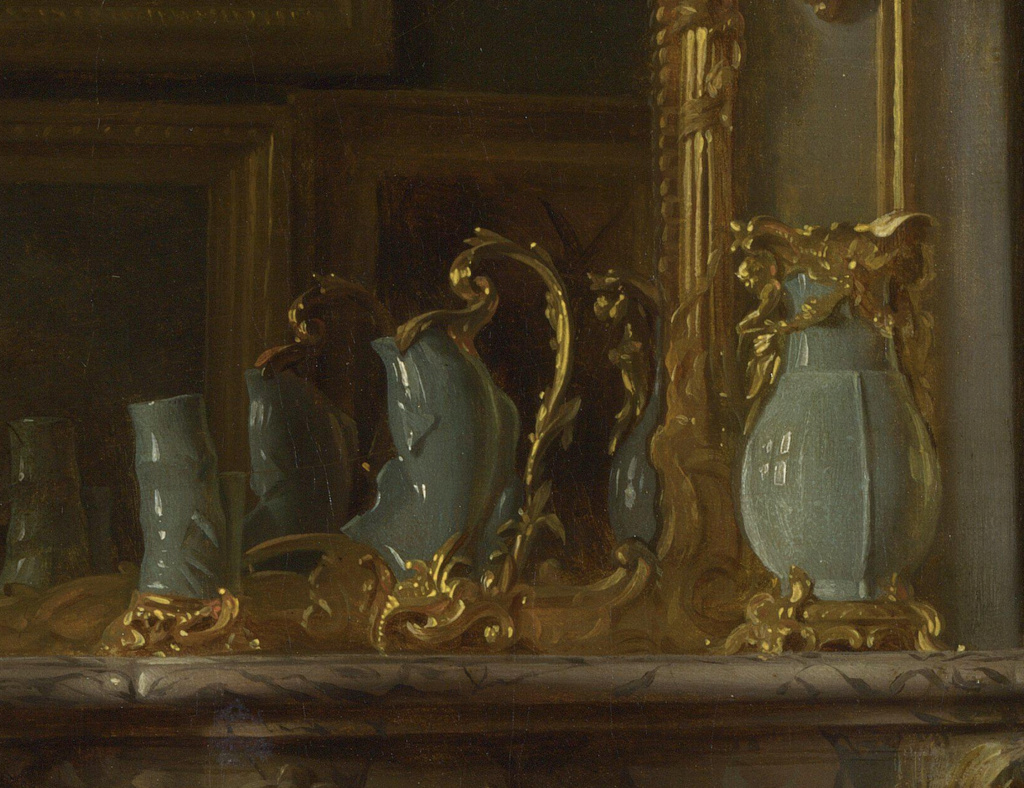

Lot Essay
These extremely rare ormolu-mounted bamboo-shaped brush-pot vases are identical to the vase visible on the left of the chimneypiece in Baron de Besenval's portrait by Pierre-Henri Danloux and can be associated with two known pairs : one in the Victoria and Albert Museum (inv. nos 820, 820A, 1882) and a pair sold at Christie's, London, 4 December 1975, lot 47.
They are exemplary of the unique creative involvement of the marchands-merciers such as Lazare-Duvaux who provided luxurious ormolu items for pationate collectors of oriental porcelain such as Baron de Besenval who had a particuar interest in unusual celadon wares.
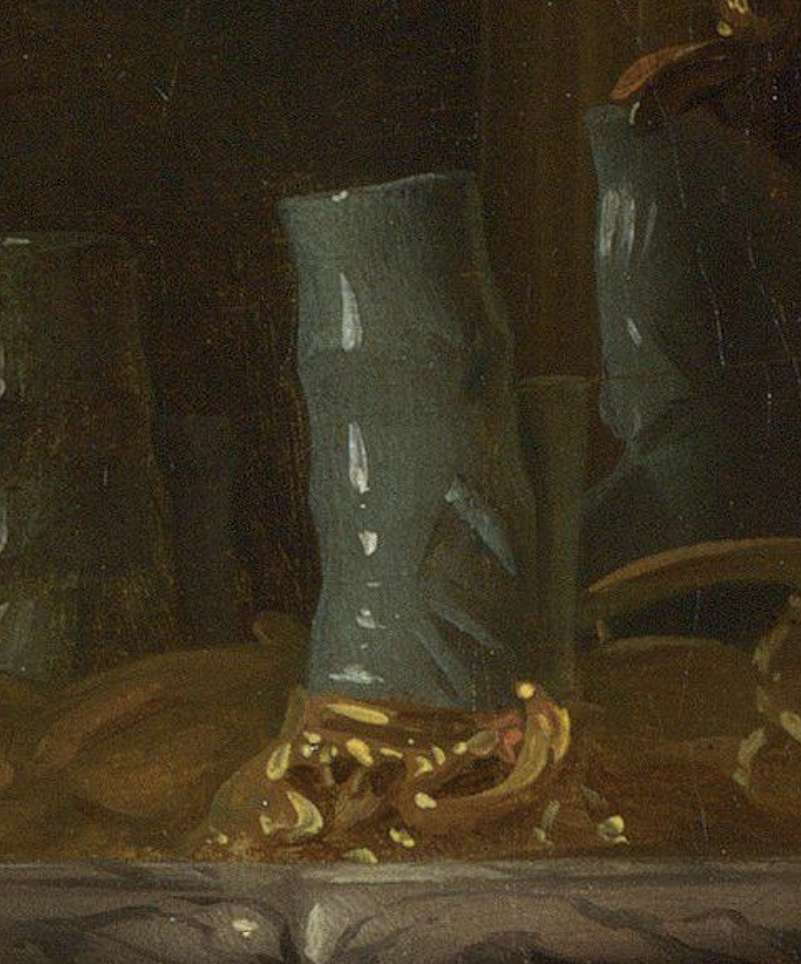
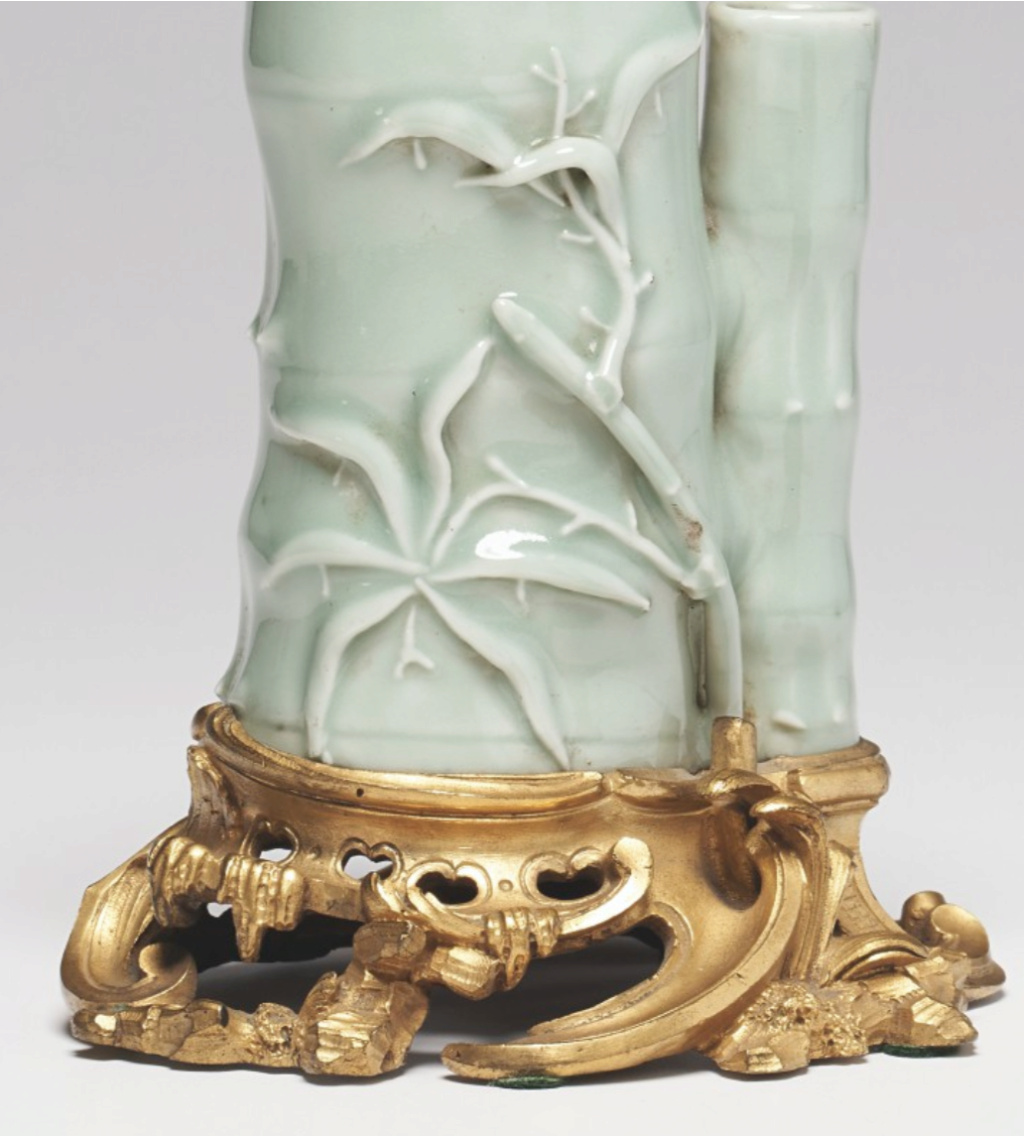
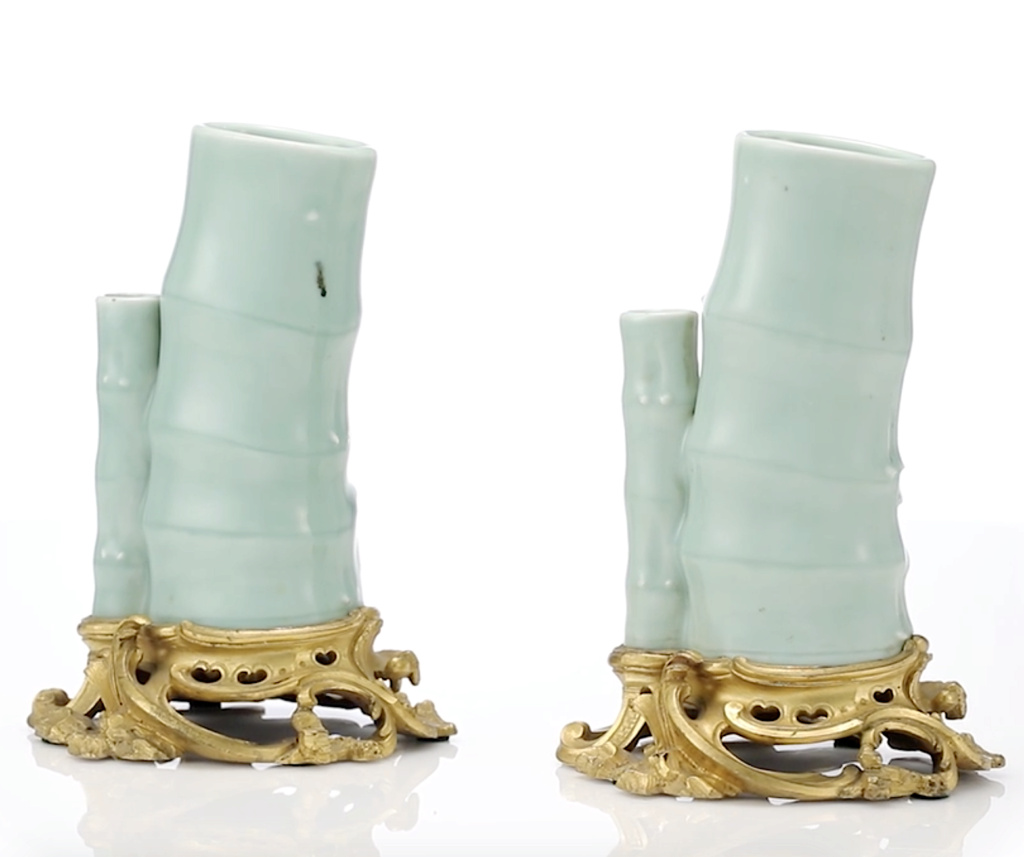
* Source et infos complémentaires pour les 3 lots : Christie's London - The Exceptional Sale (8 July 2021)

En effet, il se pourrait bien que nous retrouvions là les céramiques montées originales qui décoraient le portrait bien connu de Besenval.

Le baron de Besenval dans son salon de compagnie
Henri-Pierre Danloux
Huile sur toile, probablement vers 1791
46,5 cm x 37,0 cm
Image : The National Gallery
Seront prochainement présentés en vente aux enchères :
THE ORMOLU MOUNTS ATTRIBUTED TO JEAN-CLAUDE CHAMBELLAN DUPLESSIS, CIRCA 1760,
THE PORCELAIN CIRCA 1720-1750
Each with flask-shaped body inspired by bronze prototypes, surmounted by a shaped oval neck centered by a rockwork shell and flanked by fluted borders and scrolls, above cherub clasps suspending floral garlands, the shaped rectangular base with reeded border and foliate and cabochon-cast corner clasps, on pierced oval feet cast with foliage
12 in. (30.5 cm.) high; 6 ¼ in. (16 cm.) wide; 4 in. (10 cm.) deep

Provenance :
Almost certainly Baron de Besenval (1722-1791) in his hôtel in the rue de Grenelle, Paris, probably sold Paris, 10 August 1795 as part of lot 148.
Either acquired by Peter, 5th Earl Cowper (D. 1836), directly for Panshanger, Hertfordshire, or by Thomas, 2nd Earl de Grey (D. 1859) for Wrest Park, Hertfordshire, and subsequently through De Grey's daughter to Panshanger until circa 1953 and thereafter by descent until sold, Christie's King Street, 6 December 2007, lot 130.


Lot Essay
Precisely depicted in Baron de Besenval’s portrait by Henri-Pierre Danloux, these sumptuously mounted vases are in the late rococo style of around 1760, which represented a reaction to the fanciful asymmetry of early rococo, the goût pittoresque of the 1730s and 1740s.

The feet and spouts are curved, and the upper rim is centred by large, shell-like rocaille, but the overall design is fully symmetrical, a feature characteristic of designer and bronzier Jean-Claude Chambellan Duplessis’ oeuvre.
The reeded lower border, the naturalistic garlands of flowers, and the figures of draped boys at the sides - supporting the rim with their right hand and holding the floral swags with their left one - herald the advent of a new classicism. At a time when an aggressive neo-classicism, the so-called goût grec, was already being advocated by a small number of avant-garde patrons and artists, many preferred the generous, sweeping forms of this rococo rectifié.


The beautifully chased mounts adorn rare celadon vases whose shape is derived from Chinese archaic bronze vessels. No other similar pair appears to be recorded, although nearly identical bases occur on other pieces, such as a pair of clair de lune pagoda vases in the Rijksmuseum (C. Jörg, Chinese ceramics in the collection of the Rijksmuseum, Amsterdam, Amsterdam-London 1977, no. 266) and a bottle-shaped vase in the Wrightsman Collection (acc. num. 49.7.80- 81, F.J.B. Watson, the Wrightsman Collection, vol. II, Furniture, gilt bronze and mounted porcelain, carpets, New York, 1966, p. 239).

The already strong likelihood of these vases being those in the Besenval portrait is further supported by the existence of two pairs with the same mounts, but very obviously different decoration on the porcelain.
The pair mentioned above in the Wrightsman collection is decorated with relief key-pattern, the pair was in William Beckford's Collection at Fonthill, that of his son-in-law, the Duke of Hamilton at Hamilton Palace, were exhibited in William Beckford: An Eye For the Magnificent, 2006, no. 46. A further pair decorated with a second peach pattern, also in the collection of William Beckford at Fonthill, was subsequently sold Christie's London, 4 July 2013, lot 39.

TWO REGENCY COLLECTIONS : THE COWPER COLLECTION AT PANSHANGER AND THE DE GREY COLLECTION AT WREST PARK
- Spoiler:
- This pair of vases was almost certainly acquired by either Peter, 5th Earl Cowper (d. 1836) for Panshanger, or by Thomas, 2nd Earl de Grey for Wrest Park, also in Hertfordshire. the latter's collection of French furniture and objets was partially inherited at Panshanger. Panshanger was built from 1807-20 by the architect William Atkinson (d. 1839), Thomas Hope's architect at Deepdene, surrey. He rebuilt Repton's house at Panshanger in the prevalent antiquarian taste. The picture collection, substantially the creation of the collector 3rd Earl, who had lived largely at Florence, and improved by the 5th Earl, was much admired by Waagen on his visit in 1835.
A plausible alternative source for these vases in the Panshanger collection is Thomas Philip Weddell, 5th baron Lucas, 3rd Lord Grantham and later 2nd Earl de Grey (1741-1859) of Wrest park, Hertfordshire. A celebrated Francophile and amateur architect, while 'at Paris some years before' de grey 'had paid a good deal of attention to small pavilions or buildings in gardens with a view to lodges or park gates at Wrest' and as early as 1826 he had designed new entrance lodges on the estate in the French manner. On inheriting Wrest from his aunt in 1833, however, de Grey embarked upon a comprehensive rebuilding programme.
Acting as architect himself, with the assistance of James Clephane, he razed Giacomo Leoni's earlier house to the ground, although retaining the celebrated garden pavilion designed by Thomas Archer. Armed with the inspirational architectural treatises of J. Courtonne, Le Blond, Le Roux, Blondel and l'Assurance he proceeded to design an early louis xv House in the English countryside, completed in 1839 at a cost of £92,832 35 8d.
As the letter to his son so tellingly reveals (Bedfordshire Historical Record Society, vol. 59, no. 1980, pp. 65-85), the mansion was a comprehensive essay in Francophile taste. The tapestry room, for instance, was originally to be hung with the Gobelins suite from his house at Newby, acquired by his cousin William Weddell in Paris circa 1765-6, before protracted negotiations for Lord Dundas's similar Gobelins tapestries at Arlington street were pursued. These ultimately came to nothing, and in the end de Grey commissioned a suite of hangings from the Beauvais factory, after his own designs, which were ordered through monsieur Salandrouze. The boudoir was painted with medallions 'of Watteau-like figures, as like a Sevres cup as we could make them', while the doors for the saloon re-used some 'French wainscotting bought for George IV for Windsor castle by Mr Walsh porter'
De Grey's goût was very much in the vanguard of the revival of interest in ‘Buhl’ furniture and French taste promoted by George, Prince of Wales, later George IV. It is, therefore, extremely interesting that de Grey mentions 'the other four vases i bought off Baldock' in his letter. the Marchand-mercier Edward Holmes Baldock (d. 1854), 'purveyor of china, earthenware and glass' to William IV (1832-7) and purveyor of china to Queen Victoria (1838-45), was responsible for the formation of many of the greatest early 19th century collections of French furniture including, other than that of George IV, those of the Dukes of Buccleuch and Northumberland, William Beckford and George Byng.
The predominance of ‘Buhl’ furniture in the de Grey collections at both Wrest and Newby Hall, Yorkshire, may well point to the assistance of Baldock, and his expertise in acquiring the greatest mounted porcelain for his English clients may also suggest his involvement in the acquisition of these vases.
ALMOST CERTAINLY SUPPLIED BY LAZARE DUVAUX,
THE PORCELAIN QIANLONG (1735-1795), THE MOUNTS CIRCA 1750-1755
The porcelain bodies naturalistically modeled with a carp and its young with open mouths, each issuing elaborately chased ormolu mounts with C-scrolls and scrolled acanthus, the S-pattern handle wrapped with bulrushes and C-scrolls on elaborate naturalistically modeled plinth with bold C-scrolls, coral, acanthus, shells and sponges, the base with ormolu-applied plate to the underside
12 ½ in. (31.8 cm.) high; 7 ¼ in. (18.5 cm.) deep

Provenance :
Possibly Pierre-Victor baron de Besenval in his hôtel in the rue de Grenelle, Paris and subsequently sold Paris, 10 August 1795, as part of lot 148.
The Rodolphe Kann Collection (1844-1905), Paris.
Martin and Laura Bromberg, Hamburg; acquired from the estate of the above via Duveen & Co, London, 14 September, 1907.
Henry and Hertha Bromberg, Hamburg, by descent.
Galerie F Kleinberger (Allan Loebl), Paris, acquired from the above, circa December 1938.
Wildenstein Collection, acquired from the above, 6 March 1939.
Thence by descent in the family until sold, Christie's, King Street, 14-15 December 2005, lot 45.
Private collection, United States.
(...)


Lot Essay
This model is first recorded in the Livre-Journal of the marchand-mercier Lazare Duvaux in 1750. On 16 October, Louis XV's mistress Madame de Pompadour, (née Antoinette Poisson) acquired '621. Du 10 Mme la Marq. de Pompadour..Quatre morceaux de porcelaine céladon, dont deux en forme de cornets & deux poissons, le tout garni en bronze doré d'or moulu'.
In 1752, the marquise bought a further deux poissons céladon (cabinet de Versailles) and the taste was rapidly echoed throughout the Court, particularly amateurs like M. Gaignat, Jean de Juliennne and Blondel d'Azincourt.

Duvaux's Livre-Journal reveals the discrepancy in cost between the varying models and the quality of the ciseleur, although the cost of the porcelain itself far exceeded that of the ormolu mounts. Thus, Watteau's great patron Jean de Julienne's pair, acquired from Duvaux on the 27 June 1753 and described as 'Deux poissons de porcelaine céladon, formant des cruches, montés en bronze doré d'or moulu cost 960 livres'; in 1751 M. Gaignat acquired 'Deux poissons d'ancienne porcelaine céladon, garnis en bronze doré d'or moulu, form de buire', which this time cost 1200 livres and was depicted by Gabriel de Saint-Aubin as marginalia in one of his sale catalogues ; the pair acquired by Blondel d'Azincourt, the Intendant des Menus-Plaisirs and a most exacting patron, were almost double the first - 17 October 1755 'M. d'Azincourt..Deux poissons aussi céladon montés en buires, 1800 l'; A pair mounted as ewers was also sold to the ‘Prince de Turenne’ on 13 December 1754 and to ‘Monseigneur le Duc d’Orléans’ on 20 March 1756.

A clearer understanding of the relative costs of such elaborate ormolu mounts vis-à-vis the porcelain can be gleaned again from Duvaux, who in 1752 supplied Madame de Pompadour with 'Quatre pieds à contours en cuivre ciselé doré d'or moulu pour deux petits vases de porcelain brune & deux poissons céladon (Cabinet de Versailles), [42 l]'.
The enduring popularity of the model throughout the second half of the 18th century is confirmed both through Duvaux's Livre-Journal and the comparatively high proliferation of this model in 18th century sale catalogues and Inventories.
Indeed, even as the ancien régime was crumbling, Louis XVI's Commander-in-Chief of the ill-fated Swiss Guards, the Baron de Besenval, was immortalised in Henri-Pierre Danloux's 1791 portrait with just such a pair of vases upon the mantelpiece.


A sublime reflection of the pittoresque fantasy in the full-blown Rococo style, this form of ewer was only ever intended as ornamental. Although distinctive, categoric identification of this model in 18th century sales records is nigh on impossible owing to both the brief descriptions and the fact that three closely related models were executed, all presumably by the same bronzier working for Duvaux.
These three models comprise :
VASES OF THE WILDENSTEIN MODEL, WITH THE FISHES MOUTH AS A SPOUT:
- a pair sold from the collection of Conseulo Vanderbilt, Sotheby's, New York, 9 December 1994, lot 136. This pair is almost identical to the present and can be as well the vase visible in Danloux’s portrait of Baron de Besenval. Other pairs with slight different mounts to the carps’ lips are known:
-a pair at Harewood House, Yorkshire; these also have the same ormolu plate to the underside.
-a pair in the Royal Collection (RCIN 360).
-a garniture of three in the Calouste Gulbenkian Foundation, Lisbon (Isabel Pereira Coutinho, Gulbenkian Museum, 1998, no.100, p.126);
-a pair in The Fine Arts Museums of San Francisco (1927.165; 1927.166).
-a pair sold by Lord Robert Crichton- Stuart, Sotheby’s, London, 3 July 1959, lot 114.
-another pair was sold (without dating) from the Basil and Elise Gouland collection at Christie’s, London, 11 June 1992, lot 64.
VASES WITH THE TAIL AS THE SPOUT: these include the pair from the Hastings Collection at Melton Constable, Norfolk, now in the Widener collection at the National Gallery of Art, Washington (discussed in Sir Francis Watson, 'Mounted Oriental Porcelain', Exhibition Catalogue, Washington, 1986, no.32).
VASES IN THE FORM OF PAIRED CARP, such as the central vase of the Gulbenkian Garniture cited above, as well as that in the Victoria and Albert Museum, London (illustrated in J. Lunsingh Scheerler, Chinesisches und Japanisches Porzellan in europaîschen Fassungen, Wurzburg, 1980, p.336, fig. 329); as well as those offered anonymously at Sotheby's New York, 3 May 1986, lot 40.
THE BROMBERG FAMILY
- Spoiler:
- Dr. jur. Henry Bromberg (1878-1971) was part of the prominent extended family of renowned collector Rodolphe Kann (1845- 1905). This family included not only the Brombergs – Henry’s father Martin (1850- 1918) had married Eleonore Kann (1852-1927), Rodolphe’s sister, – but also the Emdens. Martin’s collection of Old Masters and decorative arts, as documented in a 1913 private publication, was expanded by Henry’s own collecting and curation. Henry married Hertha née Calmon (1899-1964) and they lived in a large mansion in Hamburg-Eppendorf with their four sons.
When the Nazis came to power, the Bromberg faced the increasing restrictions and persecutory measures levelled at Germany’s Jewish community. They made preparations to emigrate to the United States via Switzerland in 1938, including paying the punitive ‘flight’ and property taxes, funded partly by the forced sale of artwork. To further fund their flight, Henry Bromberg sold a number of pieces, including these vases, to the Paris-based dealer Allen Loebl.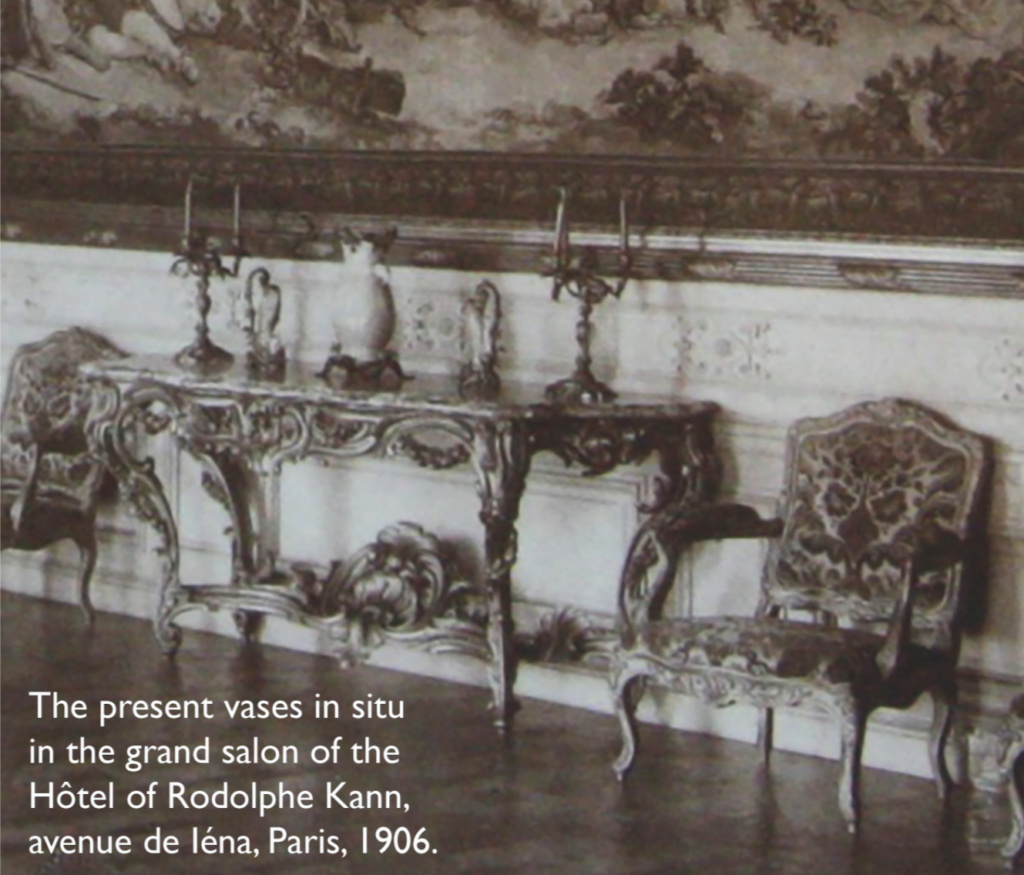
THE PORCELAIN QIANLONG (1735-1795), THE MOUNTS CIRCA 1750
Each with pierced scrolling rocaille base
7 in. (18 cm.) high

Provenance :
Possibly Pierre-Victor baron de Besenval in his hôtel in the rue de Grenelle, Paris and subsequently sold Paris, 10 August 1795, as part of lot 148.
With Michel Meyer, Paris, circa 1970.
Anonymous sale; Sotheby's Paris, 22 October 2008, lot 58.


Lot Essay
These extremely rare ormolu-mounted bamboo-shaped brush-pot vases are identical to the vase visible on the left of the chimneypiece in Baron de Besenval's portrait by Pierre-Henri Danloux and can be associated with two known pairs : one in the Victoria and Albert Museum (inv. nos 820, 820A, 1882) and a pair sold at Christie's, London, 4 December 1975, lot 47.
They are exemplary of the unique creative involvement of the marchands-merciers such as Lazare-Duvaux who provided luxurious ormolu items for pationate collectors of oriental porcelain such as Baron de Besenval who had a particuar interest in unusual celadon wares.



* Source et infos complémentaires pour les 3 lots : Christie's London - The Exceptional Sale (8 July 2021)

La nuit, la neige- Messages : 18132
Date d'inscription : 21/12/2013
 Re: Le baron Pierre-Victor de Besenval
Re: Le baron Pierre-Victor de Besenval
La nuit, la neige a écrit:Voici un rapprochement d'oeuvres bien plus pertinent que celui de mon précédent message.
En effet, il se pourrait bien que nous retrouvions là les céramiques montées originales qui décoraient le portrait bien connu de Besenval.
Ce rapprochement est fascinant . Enfin moi il me laisse pantoise !
 Autant de perfectionnisme dans le détail d'objets secondaires a valeur de documentaire . Si l'on juge de la ressemblance des vases en céladon peints par Danloux avec ceux dont tu nous montres les photos, comment douter qu'ils soient ceux-là même de Besenval ? ... et comment douter aussi que la bobine du baron suisse était très exactement celle de ce portrait génial ?!!
Autant de perfectionnisme dans le détail d'objets secondaires a valeur de documentaire . Si l'on juge de la ressemblance des vases en céladon peints par Danloux avec ceux dont tu nous montres les photos, comment douter qu'ils soient ceux-là même de Besenval ? ... et comment douter aussi que la bobine du baron suisse était très exactement celle de ce portrait génial ?!! _________________
... demain est un autre jour .

Mme de Sabran- Messages : 55497
Date d'inscription : 21/12/2013
Localisation : l'Ouest sauvage
 Re: Le baron Pierre-Victor de Besenval
Re: Le baron Pierre-Victor de Besenval
Ci dessus, j'écrivais, notamment, et au sujet de l'impressionnante "salle de bains" de l'hôtel de Besenval...
 Présenté prochainement en vente aux enchères...
Présenté prochainement en vente aux enchères...
A PAIR OF RECTANGULAR TERRACOTTA PREPARATORY RELIEFS FOR THE SALLE DE BAINS OF THE HÔTEL DE BESENVAL
ONE DEPICTING CUPID AND VENUS, SALMACIS AND HERMAPHRODITE AND LEDA AND THE SWAN AND THE OTHER DEPICTING THE BATH OF VENUS
CLAUDE MICHEL, CALLED CLODION (FRENCH, 1738-1814)
CIRCA 1780-82
Both signed 'CLODION'
13 x 37 3/4 x 2 1/4 in. (33 x 98.4 x 5.7 cm.) Leda and the Swan
13 1/4 x 38 3/4 x 2 1/2 in. (33.7 x 97.1 x 6.4 cm.) Bath of Venus
Provenance
Peter-Josef-Victor, baron de Besenval et de Brünstatt (1721-1791), hôtel de Besenval, 142 rue de Grenelle, Paris.
Anonymous sale or possibly d'Espagnac or Tricot, Le Brun, Paris, 22 May 1793, no. 187.
with Dalva Brothers, New York, 1986.
Acquired by Ann and Gordon Getty from the above in 1986.
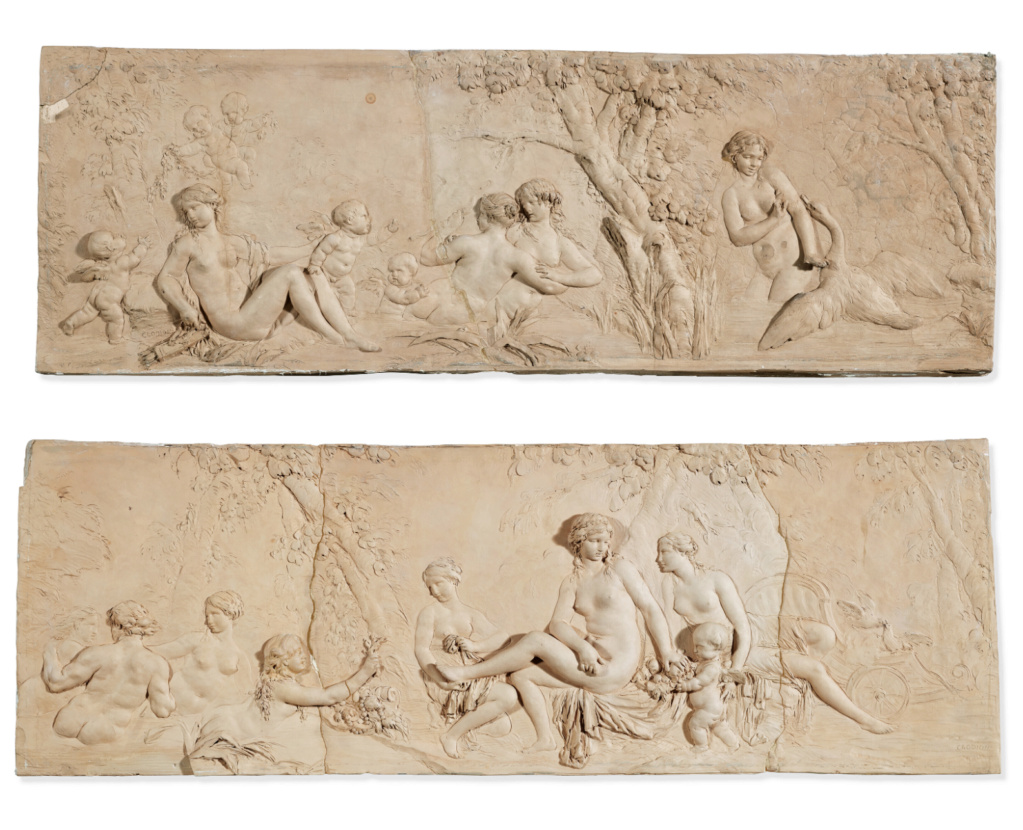
LOT ESSAY
'Lost' and now 'found'
Prominently displayed in the Entrance Hall of the Getty residence, it might come as a surprise to the family that these reliefs have been considered ‘lost’. They were, clearly, as carefully chosen and deliberately positioned as everything else in a collection full of decorative arts masterpieces. However, for those outside the walls of this house, the existence of these reliefs comes as an astonishing and delightful surprise.
The fact that they even still survive is nothing short of a miracle. Conceived as preparatory models out of the incredibly fragile material terracotta, Clodion probably only used these reliefs as sketches meant to be viewed by his patron Besenval and his architect Brongniart.
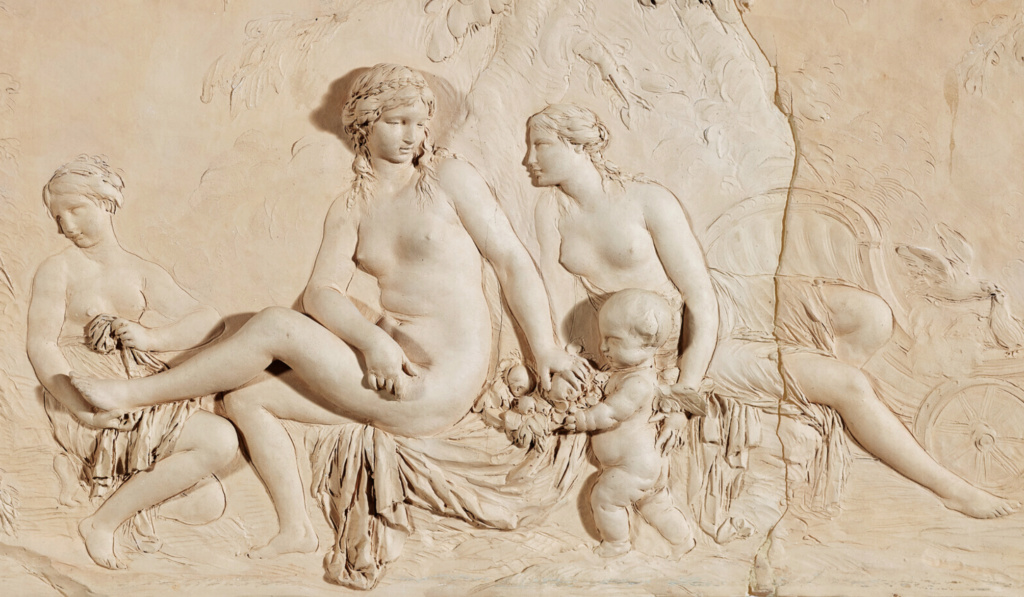
The finished stone reliefs installed in Besenval’s famous salle de bains, now both in the collections of the Louvre, are perhaps Clodions’s most ambitious sculptural accomplishment. However, now that these terracottas are ’found’, they can be widely appreciated as masterpieces of French neoclassical sculpture created by one of the most celebrated artists of the 18th century and for one of the most important collectors of the Ancien Régime.
The Baron
The architect and the artist
As a hyper-sophisticated aesthete, it is no surprise Besenval would have turned to Clodion and Brongniart to build his famous salle de bains.
Alexandre-Théodore Brongniart (1739-1813), was a well-connected and superbly-talented and fashionable architect who designed many prominent private residences and public buildings in the last years of the Ancien Régime. He also successfully transitioned into one of Emperor Napoleon’s favorite architects and was responsible for the layout of Paris’s most famous cemetery, Père Lachaise, as well as the Paris Bourse (stock exchange) which is still named the Palais Brongniart, in his honor. Brongniart, a close friend of the sculptor Jean-Antoine Houdon, was clearly intensely sympathetic to the integration of sculpture and architecture. Indeed in his salle de bains for Besenval, sculpture, and of course Clodion, were given center stage.
Poulet and Scherf extensively discussed Clodion’s role in Besenval’s salle de bains in their ground-breaking exhibition catalogue on Clodion held at the Louvre in 1992. Clodion, one of the most fashionable artists working in Paris in the 1780s, with other projects for the prince de Condé and the comte d’Artois, would have been a natural choice. Clodion’s masterful mixture of sensuality and intimacy under the guise of a cool classicism was the ideal artist for Besenval’s project.
Clodion was commissioned to provide not only the two enormous stone reliefs that are now in the Louvre, the first, Venus and Cupid with Leda and the Swan and the second, Pan pursuing Syrinx with Cupid watching, but also a set of four vases which are all now in the Louvre.
And, lastly, Clodion produced the focus of the entire room, a figure of a reclining woman with a vase pouring water, La Source, which ended up in the Rothschild collections.
When Besenval’s salle de bains was finished, it became immediately famous and was praised as among the most beautiful, luxurious and modern interiors of Paris.
After the Revolution started, the satirist Rivarol wrote that Besenval ‘…let the Invalides be taken because he was afraid that if the rioting became too widespread, they would pillage his house in which he had just had an entire apartment painted and charming baths installed. These are the kind of men who served the King!.’
Despite the attention to the design and execution, practically, however, Besenval’s baths were a disaster. Anecdotally, the baths were actually used only once, by a Swiss Guard who then shortly thereafter died of pneumonia.
In any case, the humidity was intense and, ultimately, too destructive for Clodion’s sculptures which were all removed in the 1820s.
Despite the apparent simplicity of the subject matter of Clodion’s reliefs water, bucolic settings and beautiful women bathing the iconography is intensely complex. Scherf has extensively detailed the varied literary and artistic sources Clodion drew upon and which are reflected in these reliefs. Clodion was directly inspired by Antique cameos, wall frescoes at Herculaneum, the Renaissance paintings of Correggio and Carracci as well as contemporaries, such as the sculptor Falconet.
Love is everywhere, with the putti presenting flowers and encouraging pleasure yet the restraint of love is also present symbolized by Venus disarming the cupids and holding their wings.

The relief of Leda and the Swan differs slightly from Clodion’s finished relief which is now in the Louvre, as it is slightly more complex, so Clodion might have modified the final version to make carving the stone relief simpler. As Scherf notes, in the Getty relief, there are two additional putti in the air and a third in the water and the tree to the right is more bushy (Scherf, 1992, p. 230).
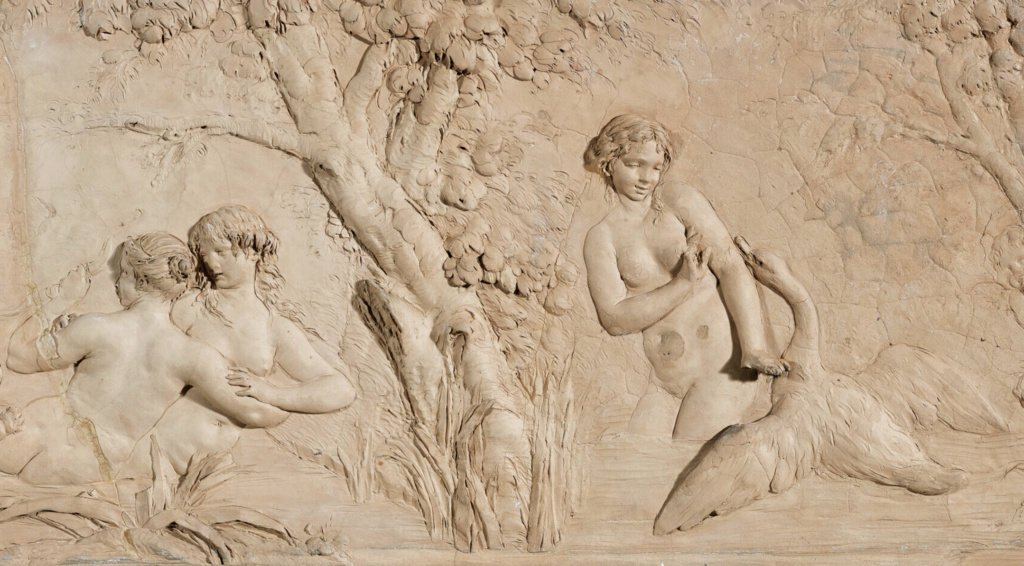
Interestingly, in Brongniart’s architectural drawings of the salle de bains, it is the Getty relief of Leda and the Swan that is represented, indicating that the Getty relief was Clodion’s original design. As Scherf also notes, Clodion’s inclusion of Salmacis and Hermaphroditus was a curious choice and was possibly inspired by an illustration of Ovid’s Metamorphoses which had been translated by the abbé Banier and published in Amsterdam in 1732.
And the second scene of The Bath of Venus, apparently, did not progress further than the preparatory stage of the Getty terracotta as it has been substituted with the relief of Pan pursuing Syrinx in both Brogniart’s architectural drawings and the final realized version now in the Louvre.
Besenval’s glorious salle de bains existed only for seven short years before the Revolution. However, these remarkable reliefs remain, now newly ‘discovered,’ and are not only as reminders of one of the most intriguing interiors of the Ancien Régime but also of the baron who commissioned them, and the architect and artist who created this fantasy.
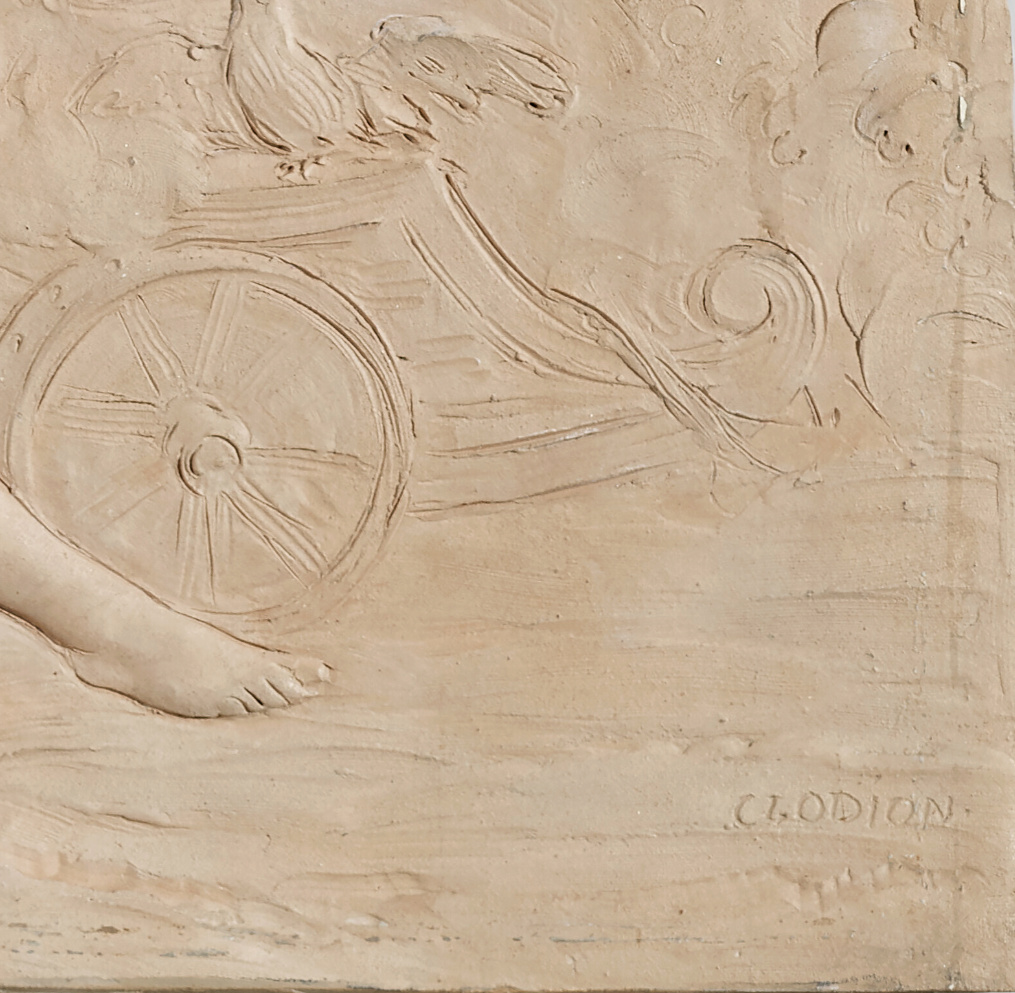
* Source et infos complémentaires : Christie's NY - The Ann & Gordon Collection
 Notre sujet : Christie's New-York - Vente aux enchères de la collection de Ann and Gordon Getty (20 octobre 2022)
Notre sujet : Christie's New-York - Vente aux enchères de la collection de Ann and Gordon Getty (20 octobre 2022)
La nuit, la neige a écrit:Les plans de cet impressionnant "nymphée" ont été conservés. Pas si mal, pas si mal.
Mais il manque les cheminées, en effet...
Alexandre-Théodore Brongniart
Paris, Hôtel de Besenval : nymphée souterrain à l'antique
Photo : RMN-Grand Palais / Michèle Bellot
Musée du Louvre
Alexandre-Théodore Brongniart
Paris, Hôtel de Besenval : nymphée souterrain à l'antique
Photo : RMN-Grand Palais / Michèle Bellot
Musée du Louvre
Alexandre-Théodore Brongniart
Paris, Hôtel de Besenval : nymphée souterrain à l'antique
Photo : RMN-Grand Palais / Michèle Bellot
Musée du Louvre
Alexandre-Théodore Brongniart
Paris, Hôtel de Besenval : nymphée souterrain à l'antique
Photo : RMN-Grand Palais / Michèle Bellot
Musée du Louvre
A PAIR OF RECTANGULAR TERRACOTTA PREPARATORY RELIEFS FOR THE SALLE DE BAINS OF THE HÔTEL DE BESENVAL
ONE DEPICTING CUPID AND VENUS, SALMACIS AND HERMAPHRODITE AND LEDA AND THE SWAN AND THE OTHER DEPICTING THE BATH OF VENUS
CLAUDE MICHEL, CALLED CLODION (FRENCH, 1738-1814)
CIRCA 1780-82
Both signed 'CLODION'
13 x 37 3/4 x 2 1/4 in. (33 x 98.4 x 5.7 cm.) Leda and the Swan
13 1/4 x 38 3/4 x 2 1/2 in. (33.7 x 97.1 x 6.4 cm.) Bath of Venus
Provenance
Peter-Josef-Victor, baron de Besenval et de Brünstatt (1721-1791), hôtel de Besenval, 142 rue de Grenelle, Paris.
Anonymous sale or possibly d'Espagnac or Tricot, Le Brun, Paris, 22 May 1793, no. 187.
with Dalva Brothers, New York, 1986.
Acquired by Ann and Gordon Getty from the above in 1986.

LOT ESSAY
'Lost' and now 'found'
Prominently displayed in the Entrance Hall of the Getty residence, it might come as a surprise to the family that these reliefs have been considered ‘lost’. They were, clearly, as carefully chosen and deliberately positioned as everything else in a collection full of decorative arts masterpieces. However, for those outside the walls of this house, the existence of these reliefs comes as an astonishing and delightful surprise.
The fact that they even still survive is nothing short of a miracle. Conceived as preparatory models out of the incredibly fragile material terracotta, Clodion probably only used these reliefs as sketches meant to be viewed by his patron Besenval and his architect Brongniart.

The finished stone reliefs installed in Besenval’s famous salle de bains, now both in the collections of the Louvre, are perhaps Clodions’s most ambitious sculptural accomplishment. However, now that these terracottas are ’found’, they can be widely appreciated as masterpieces of French neoclassical sculpture created by one of the most celebrated artists of the 18th century and for one of the most important collectors of the Ancien Régime.
The Baron
- Spoiler:
- Besenval was one of the most sophisticated men of late 18th century Europe. As the head of the Swiss Guards in France, he was a career soldier. However, he also had the interest and intellect to amass one of the most important collections of paintings and decorative arts in France. He was an honorary member of the Académie and a writer with multiple published books to his name. His most famous book, however, was the posthumous publication of his Mémoires, published by the vicomte de Ségur between 1805-1807, who may have been Besenval’s illegitimate son, and these created a sensation in France at the time as they detailed numerous and intimate scandals from the court of King Louis XVI and Queen Marie-Antoinette.
While many of the details of his Mémoires may have been exaggerated to emphasize his close connection to the King and Queen, it is indisputable that Besenval was a close friend of Marie-Antoinette and an intimate witness to the last years of her life in Paris and at Versailles. Although he was older than most of the Queen’s closest friends, his good looks, charm and intelligence made him a favorite. And, additionally, invoking his alpine heritage, there was absolutely no one else at court who dared to yodel like a Swiss shepherd in front of the Queen.
After the Revolution broke out in 1789, Besenval, made a series of catastrophic military decisions which had enormous consequences for the Bourbon dynasty, and indeed for European history. As the commander of the French troops in Paris and the Ile-de-France that remained loyal to the Crown, he gave the July 12 order for them to withdraw from Paris leaving the Bastille to be stormed on July 14. And the rest, as they say, is history. Besenval fled from Paris and was arrested shortly thereafter but spared the guillotine. After a trial at Châtelet, he was acquitted. However, disgraced by his military errors and his close association with the now-imprisoned royal family he died shortly afterwards in 1791.
The architect and the artist
As a hyper-sophisticated aesthete, it is no surprise Besenval would have turned to Clodion and Brongniart to build his famous salle de bains.
Alexandre-Théodore Brongniart (1739-1813), was a well-connected and superbly-talented and fashionable architect who designed many prominent private residences and public buildings in the last years of the Ancien Régime. He also successfully transitioned into one of Emperor Napoleon’s favorite architects and was responsible for the layout of Paris’s most famous cemetery, Père Lachaise, as well as the Paris Bourse (stock exchange) which is still named the Palais Brongniart, in his honor. Brongniart, a close friend of the sculptor Jean-Antoine Houdon, was clearly intensely sympathetic to the integration of sculpture and architecture. Indeed in his salle de bains for Besenval, sculpture, and of course Clodion, were given center stage.
Poulet and Scherf extensively discussed Clodion’s role in Besenval’s salle de bains in their ground-breaking exhibition catalogue on Clodion held at the Louvre in 1992. Clodion, one of the most fashionable artists working in Paris in the 1780s, with other projects for the prince de Condé and the comte d’Artois, would have been a natural choice. Clodion’s masterful mixture of sensuality and intimacy under the guise of a cool classicism was the ideal artist for Besenval’s project.
Clodion was commissioned to provide not only the two enormous stone reliefs that are now in the Louvre, the first, Venus and Cupid with Leda and the Swan and the second, Pan pursuing Syrinx with Cupid watching, but also a set of four vases which are all now in the Louvre.
And, lastly, Clodion produced the focus of the entire room, a figure of a reclining woman with a vase pouring water, La Source, which ended up in the Rothschild collections.
When Besenval’s salle de bains was finished, it became immediately famous and was praised as among the most beautiful, luxurious and modern interiors of Paris.
After the Revolution started, the satirist Rivarol wrote that Besenval ‘…let the Invalides be taken because he was afraid that if the rioting became too widespread, they would pillage his house in which he had just had an entire apartment painted and charming baths installed. These are the kind of men who served the King!.’
Despite the attention to the design and execution, practically, however, Besenval’s baths were a disaster. Anecdotally, the baths were actually used only once, by a Swiss Guard who then shortly thereafter died of pneumonia.
In any case, the humidity was intense and, ultimately, too destructive for Clodion’s sculptures which were all removed in the 1820s.
Despite the apparent simplicity of the subject matter of Clodion’s reliefs water, bucolic settings and beautiful women bathing the iconography is intensely complex. Scherf has extensively detailed the varied literary and artistic sources Clodion drew upon and which are reflected in these reliefs. Clodion was directly inspired by Antique cameos, wall frescoes at Herculaneum, the Renaissance paintings of Correggio and Carracci as well as contemporaries, such as the sculptor Falconet.
Love is everywhere, with the putti presenting flowers and encouraging pleasure yet the restraint of love is also present symbolized by Venus disarming the cupids and holding their wings.

The relief of Leda and the Swan differs slightly from Clodion’s finished relief which is now in the Louvre, as it is slightly more complex, so Clodion might have modified the final version to make carving the stone relief simpler. As Scherf notes, in the Getty relief, there are two additional putti in the air and a third in the water and the tree to the right is more bushy (Scherf, 1992, p. 230).

Interestingly, in Brongniart’s architectural drawings of the salle de bains, it is the Getty relief of Leda and the Swan that is represented, indicating that the Getty relief was Clodion’s original design. As Scherf also notes, Clodion’s inclusion of Salmacis and Hermaphroditus was a curious choice and was possibly inspired by an illustration of Ovid’s Metamorphoses which had been translated by the abbé Banier and published in Amsterdam in 1732.
And the second scene of The Bath of Venus, apparently, did not progress further than the preparatory stage of the Getty terracotta as it has been substituted with the relief of Pan pursuing Syrinx in both Brogniart’s architectural drawings and the final realized version now in the Louvre.
Besenval’s glorious salle de bains existed only for seven short years before the Revolution. However, these remarkable reliefs remain, now newly ‘discovered,’ and are not only as reminders of one of the most intriguing interiors of the Ancien Régime but also of the baron who commissioned them, and the architect and artist who created this fantasy.

* Source et infos complémentaires : Christie's NY - The Ann & Gordon Collection

La nuit, la neige- Messages : 18132
Date d'inscription : 21/12/2013
 Re: Le baron Pierre-Victor de Besenval
Re: Le baron Pierre-Victor de Besenval
Christie's / Descriptif au catalogue a écrit:
Clodion was commissioned to provide not only the two enormous stone reliefs that are now in the Louvre, the first, Venus and Cupid with Leda and the Swan and the second, Pan pursuing Syrinx with Cupid watching, but also a set of four vases which are all now in the Louvre.
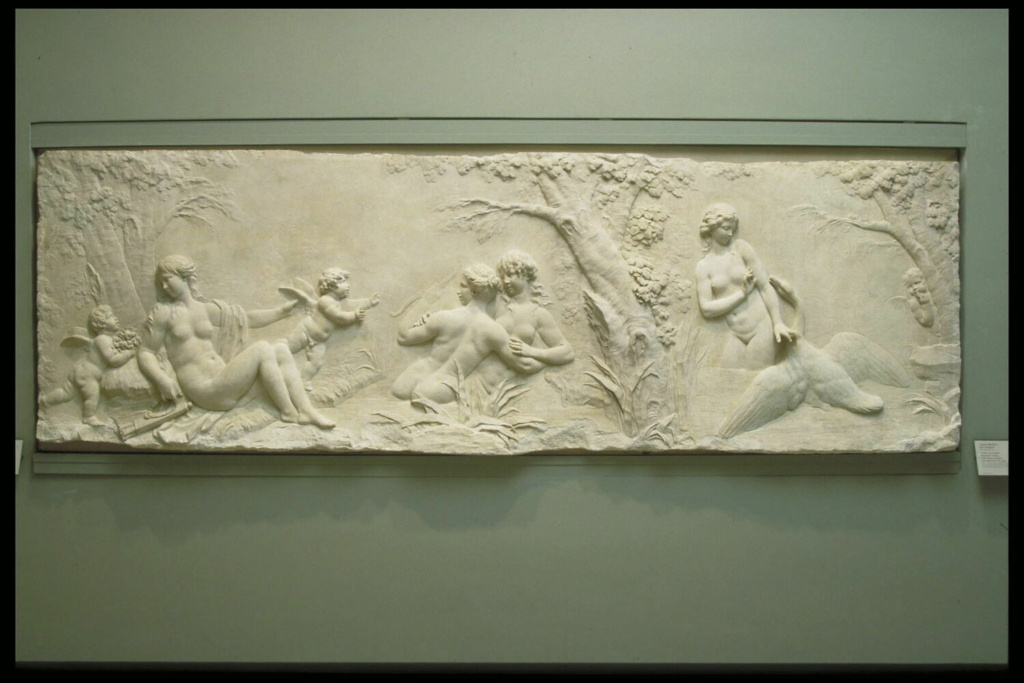
Vénus et l'Amour avec Léda et le cygne
Bas relief : Elément du décor de la salle de bains de l'hôtel du baron de Besenval à Paris
Michel, Claude dit Clodion
Pierre de Tonnerre, 1782
Hauteur : 1,03 m ; Largeur : 3,23 m ; Profondeur : 0,27 m
Image : Musée du Louvre / Pierre Philibert



Images : Musée du Louvre / Pierre Philibert

Pan poursuivant Syrinx sous le regard de l'Amour
Bas relief : Elément du décor de la salle de bains de l'hôtel du baron de Besenval à Paris
Michel, Claude dit Clodion
Pierre de Tonnerre, 1782
Hauteur : 1,04 m ; Largeur : 3,23 m ; Profondeur : 0,23 m
Image : RMN-Grand Palais (musée du Louvre) / René-Gabriel Ojéda
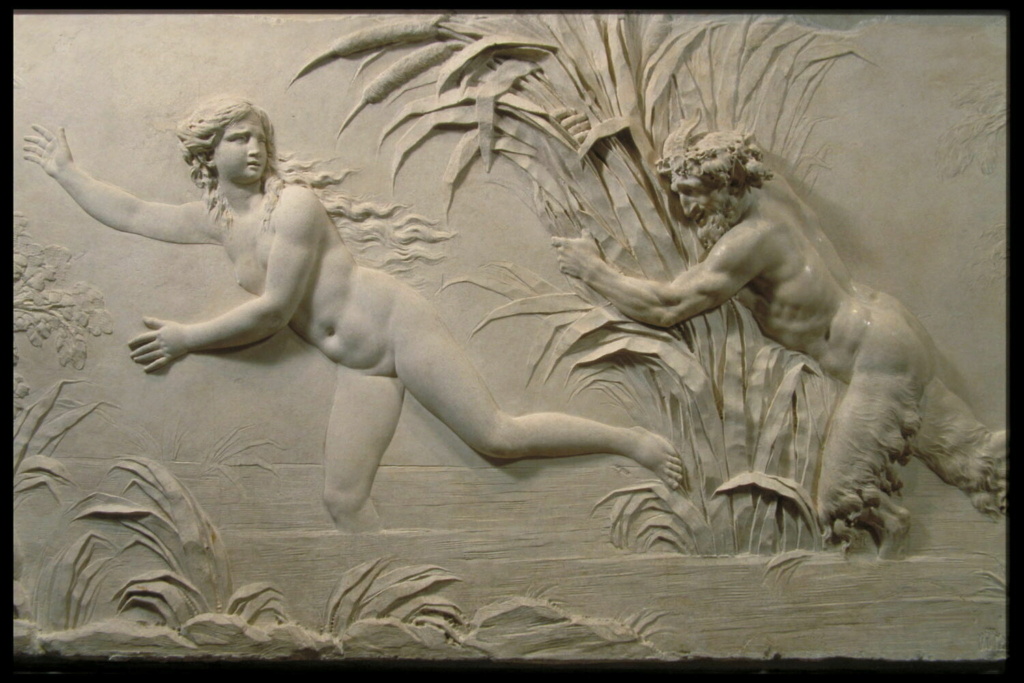
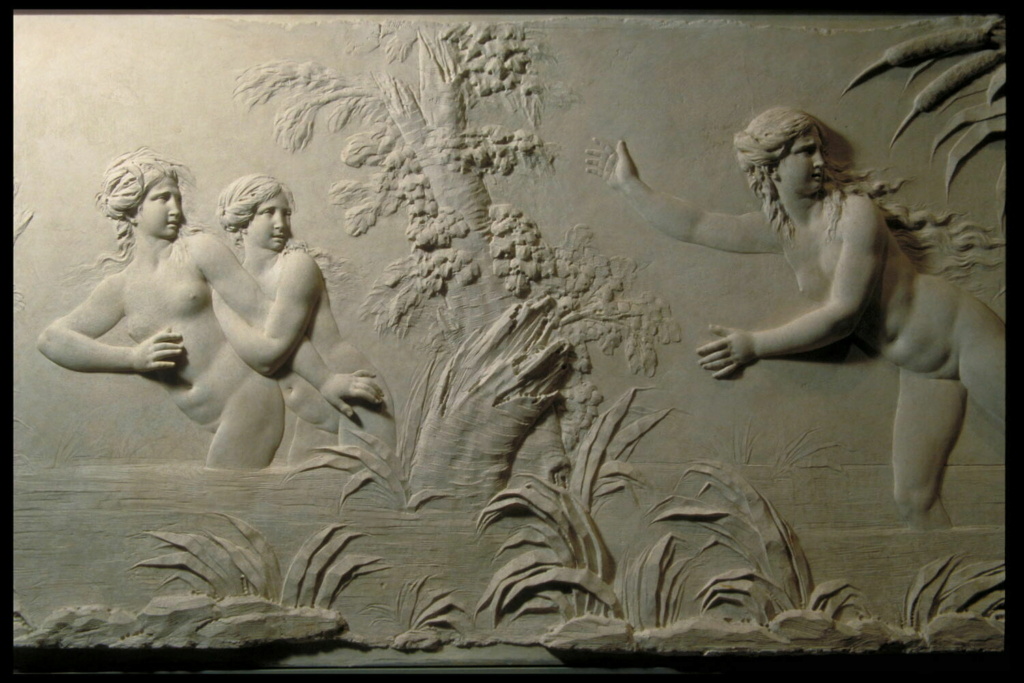

Images : RMN-Grand Palais (musée du Louvre) / René-Gabriel Ojéda

Vase à décor d'une ronde de satyres et de satyresses avec les accessoires du thiase bachique
Elément du décor de la salle de bains de l'hôtel du baron de Besenval à Paris
Michel, Claude dit Clodion
Pierre de Tonnerre, 1782
Hauteur : 1,1 m ; Diamètre : 0,42 m
Image : RMN-Grand Palais (musée du Louvre) / Adrien Didierjean
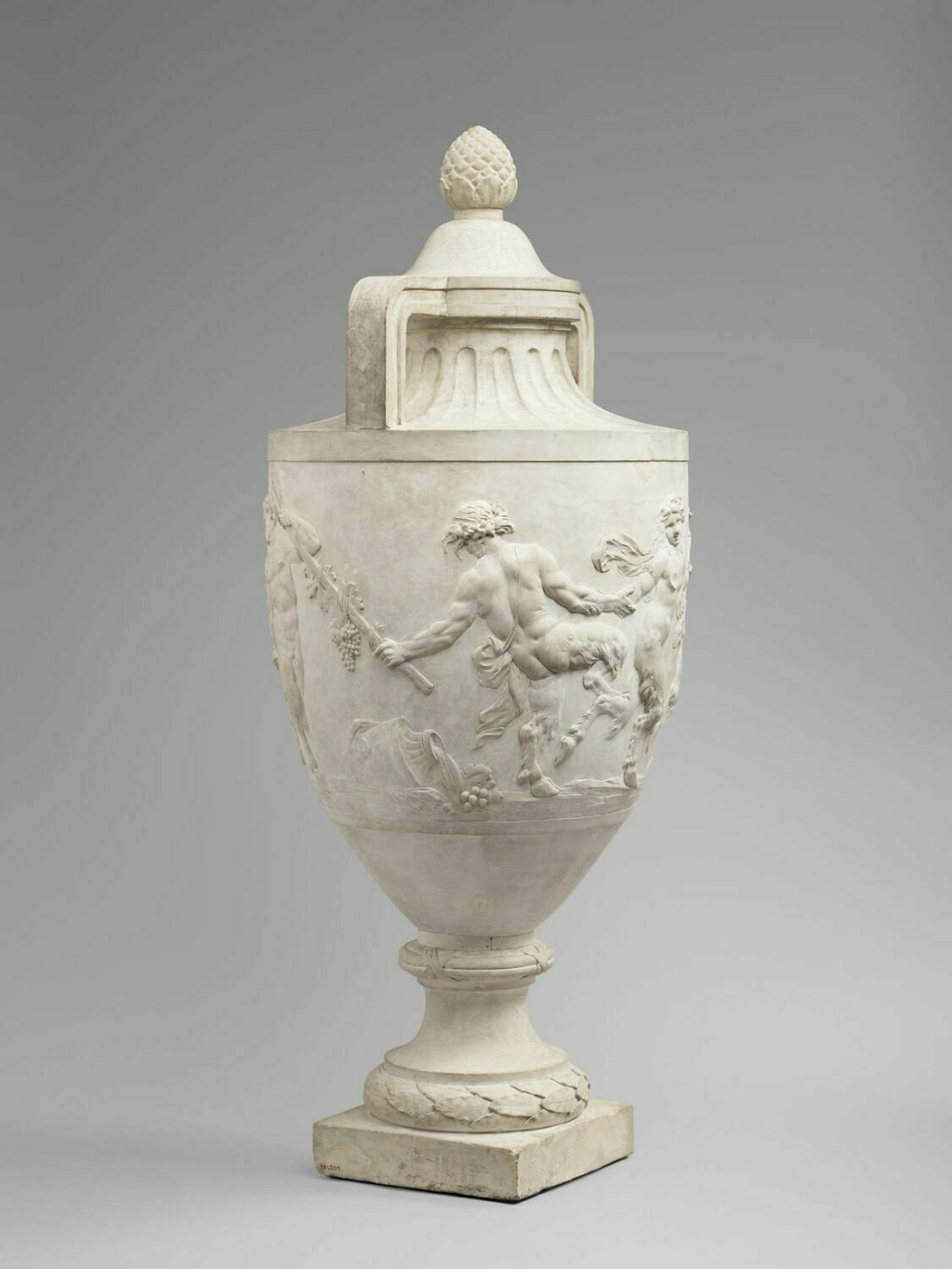

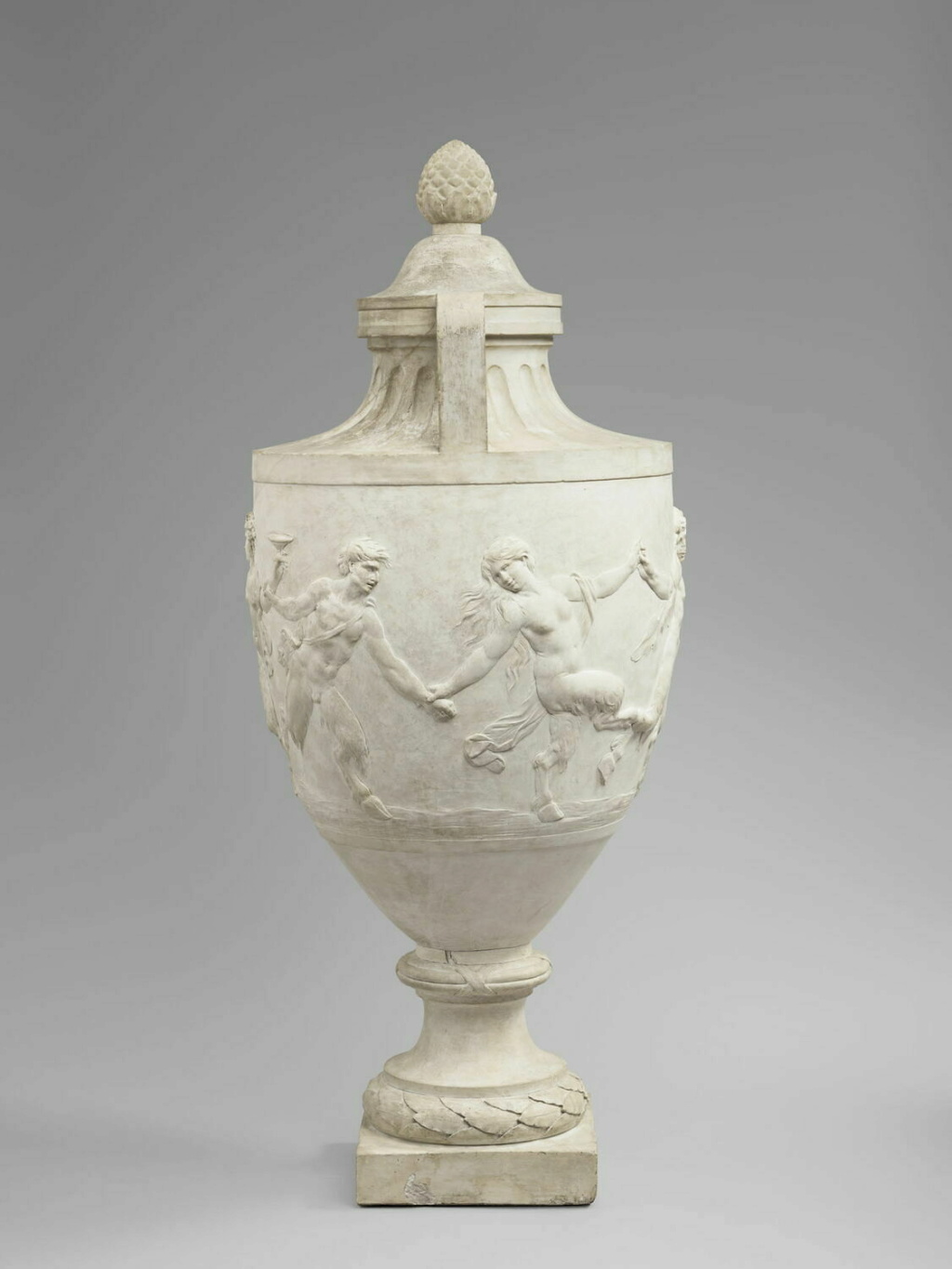
Images : RMN-Grand Palais (musée du Louvre) / Adrien Didierjean
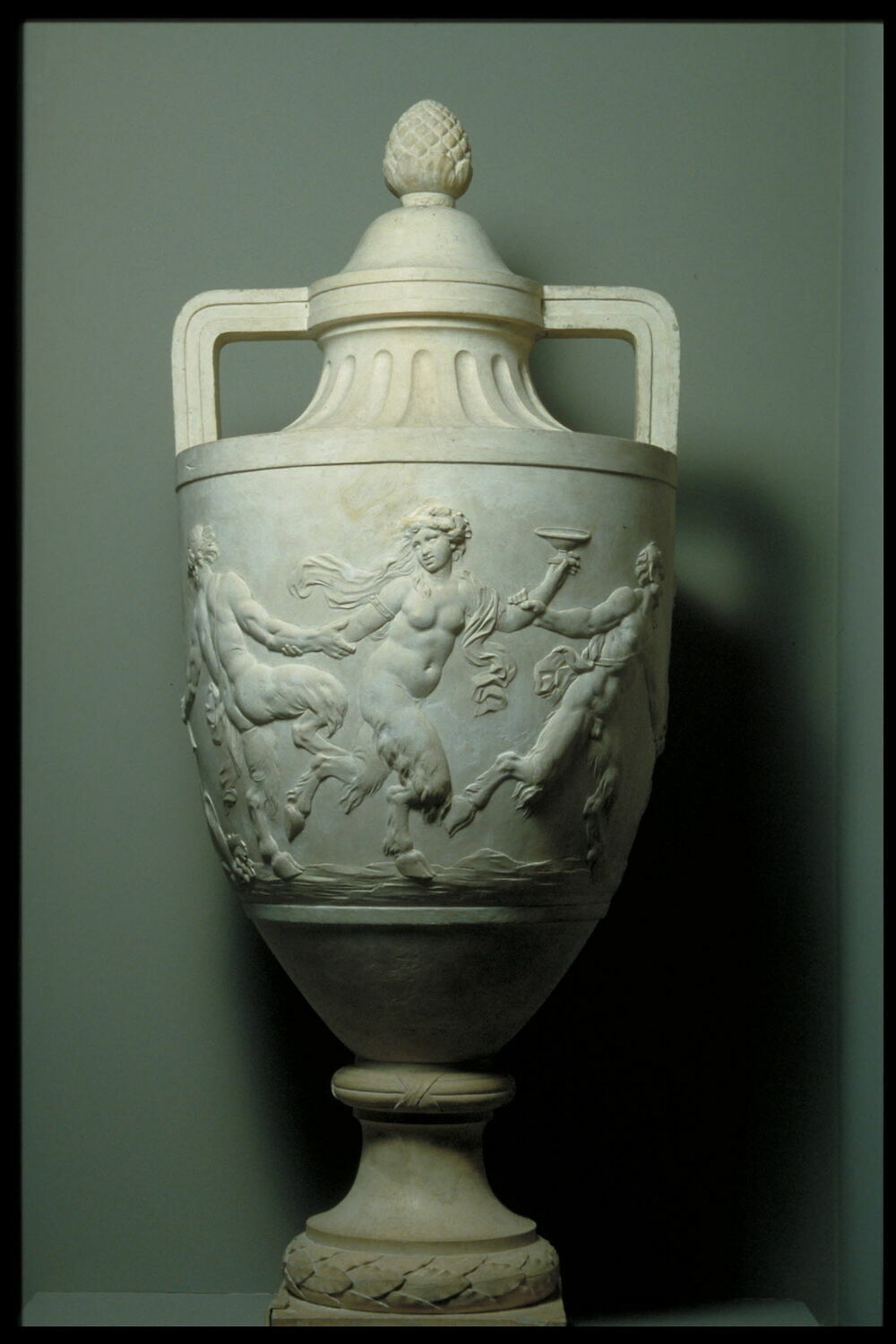
Vase à décor d'une ronde de Satyres et de Satyresses avec les accessoires du thiase bachique
Elément du décor de la salle de bains de l'hôtel du baron de Besenval à Paris
Michel, Claude dit Clodion
Pierre de Tonnerre, 1782
Hauteur : 1,1 m ; Diamètre : 0,42 m
Image : Musée du Louvre / Pierre Philibert

Vase à décor d'une ronde de satyres et de satyresses
Elément du décor de la salle de bains de l'hôtel du baron de Besenval à Paris[/b]
Michel, Claude dit Clodion
Pierre de Tonnerre, 1782
Hauteur : 1,1 m ; Diamètre : 0,42 m
Image : RMN-Grand Palais (musée du Louvre) / Adrien Didierjean


Images : RMN-Grand Palais (musée du Louvre) / Adrien Didierjean
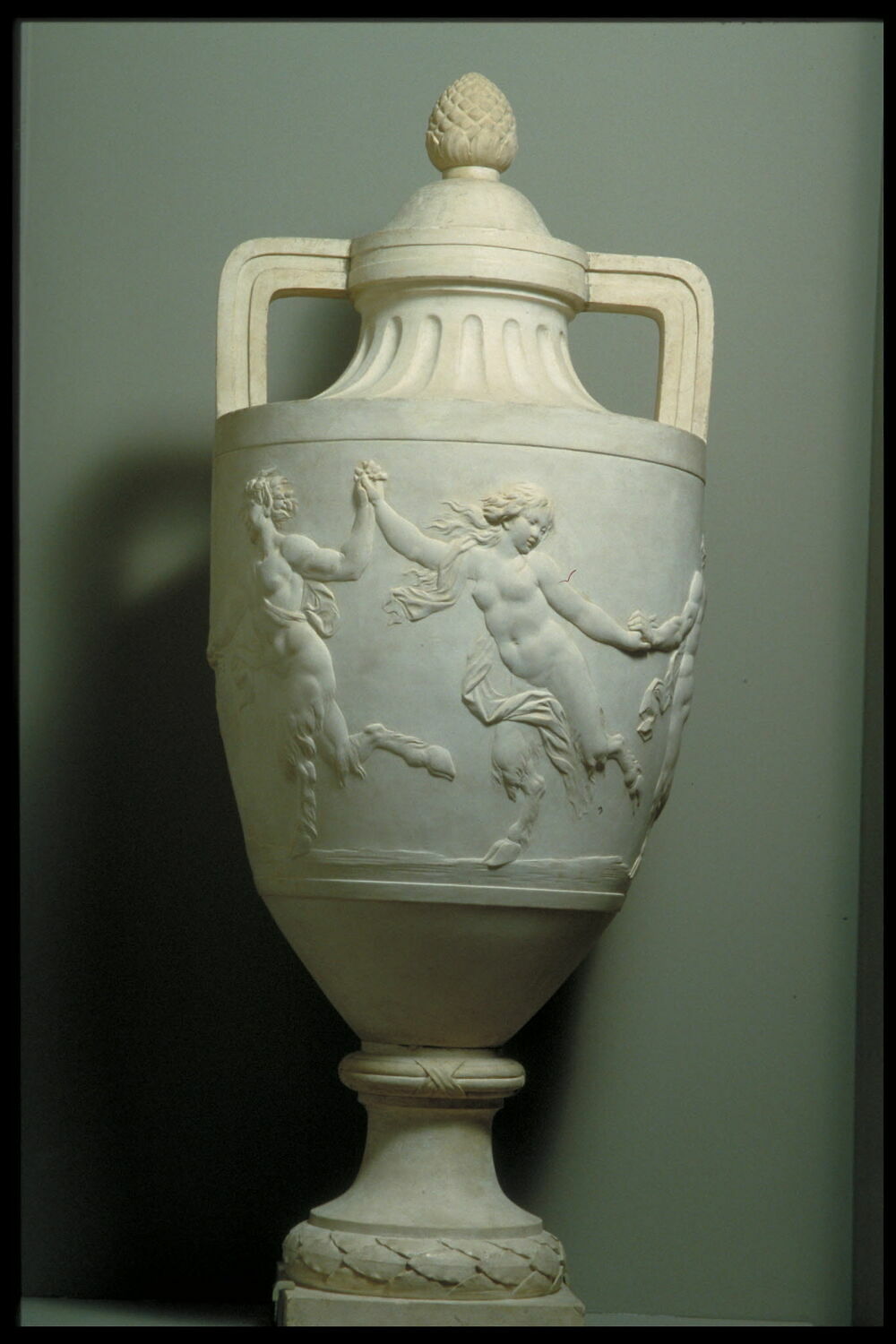
Vase à décor d'une ronde de satyres et de satyresses
Michel, Claude dit Clodion
Pierre de Tonnerre, 1782
Hauteur : 1,1 m ; Diamètre : 0,42 m
Image : Musée du Louvre / Pierre Philibert

La nuit, la neige- Messages : 18132
Date d'inscription : 21/12/2013

Mme de Sabran- Messages : 55497
Date d'inscription : 21/12/2013
Localisation : l'Ouest sauvage
 Re: Le baron Pierre-Victor de Besenval
Re: Le baron Pierre-Victor de Besenval
Et dire que cette "salle de bains" ne fut utilisée qu'une seule fois... 


La nuit, la neige- Messages : 18132
Date d'inscription : 21/12/2013
Page 3 sur 4 •  1, 2, 3, 4
1, 2, 3, 4 
 Sujets similaires
Sujets similaires» Louis-François-Armand de Vignerot du Plessis, maréchal et duc de Richelieu
» Le baron Jean-Pierre de Batz
» Documentaires et émissions historiques à voir ou revoir en vidéo (replay)
» Charles-Emmanuel IV de Piémont-Sardaigne
» Bordeaux au XVIIIe siècle
» Le baron Jean-Pierre de Batz
» Documentaires et émissions historiques à voir ou revoir en vidéo (replay)
» Charles-Emmanuel IV de Piémont-Sardaigne
» Bordeaux au XVIIIe siècle
LE FORUM DE MARIE-ANTOINETTE :: La famille royale et les contemporains de Marie-Antoinette :: Autres contemporains : les hommes du XVIIIe siècle
Page 3 sur 4
Permission de ce forum:
Vous ne pouvez pas répondre aux sujets dans ce forum

